ARRIS TG1682-2 Touchstone Wireless Telephony Gateway User Manual Xfinity TG1682G CT Telephony Gateway User s Guide
ARRIS Group, Inc. Touchstone Wireless Telephony Gateway Xfinity TG1682G CT Telephony Gateway User s Guide
ARRIS >
Users Manual
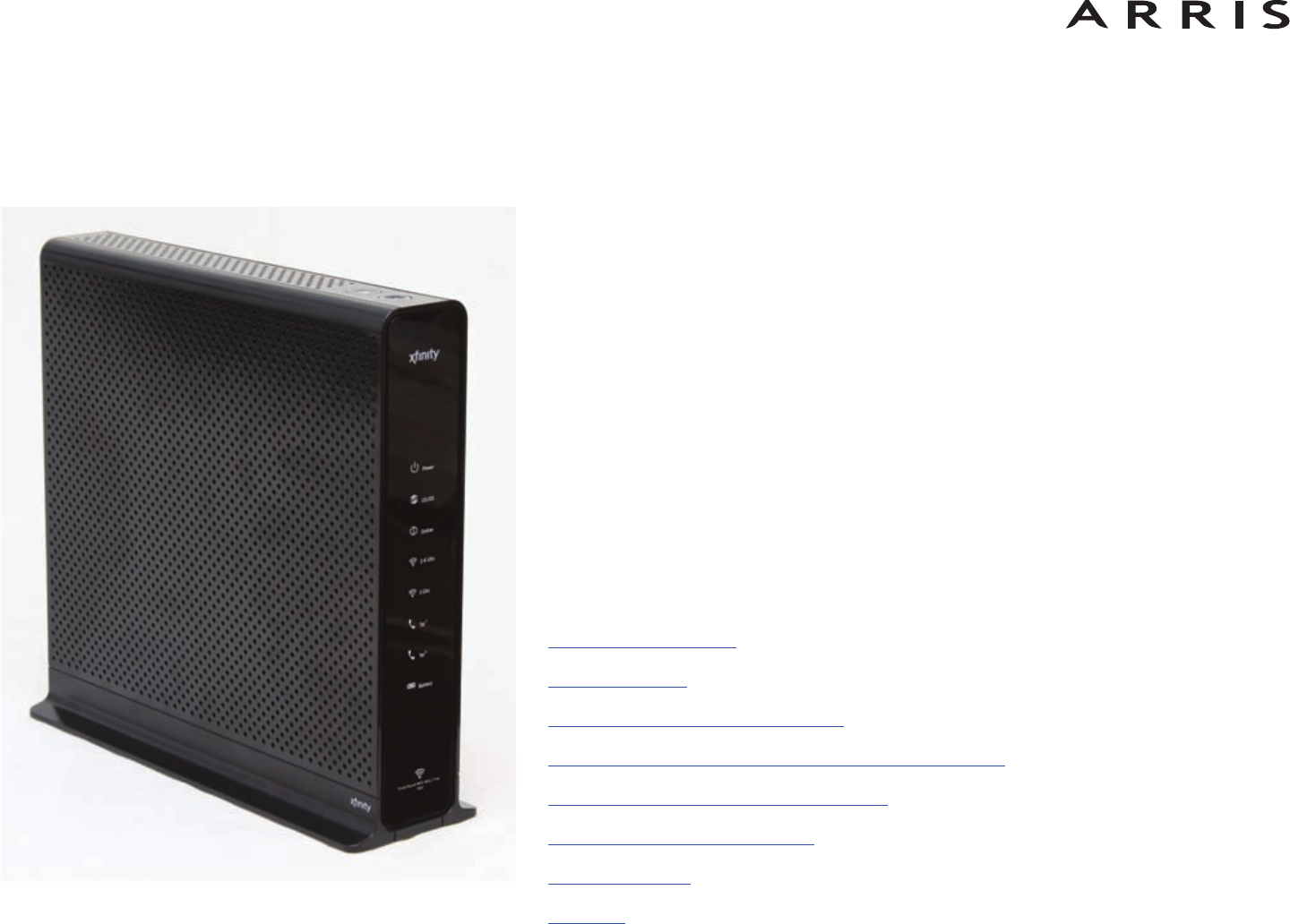
Xfinity TG1682
Telephony Gateway
User’s Guide
Get ready to experience the Internet’s express lane! Whether you’re checking out
streaming media, downloading new software, checking your email, or talking with
friends on the phone, the Xfinity TG1682 Telephony Gateway brings it all to you
faster and more reliably. All while providing toll quality Voice over IP telephone ser -
vice and both wired and wireless connectivity. It also supports a Lithi um-Ion bat-
tery backup to provide continued telephone service during power outages.
The Xfinity Telephony Gateway provides four Ethernet connections for use as the
hub of your home/office Local Area Network (LAN). The Xfinity Telephony Gateway
also provides 802.11a/b/g/n/ac wireless connectivity for enhanced mobility and
versatility. In addition, the Xfinity Telephony Gateway provides for up to two sepa-
rate lines of telephone service and Digital Enhanced Cordless Telecommunications
(DECT) funtionality to allow using cordless telphones within the home. The Tele-
phony Gateway also offers integrated MoCA 2.0 home networking providing Inter-
net access and transfer of multimedia content between devices over coaxial cable
in the home.
Installation is simple and your cable company will provide assistance to you for any
special requirements. The links below provide more detailed instructions.
Safety Requirements
Getting Started
Battery Installation and Removal
Installing and Connecting Your Telephony Gateway
Configuring Your Ethernet Connection
Using the Telephony Gateway
Troubleshooting
Glossary
Export Regulations
This product may not be exported outside the U.S. and Canada without U.S. Department of Commerce, Bureau of Export Admin istration au-
thorization. Any export or re-export by the purchaser, directly or indirectly, in contravention of U.S. Export Adminis tration Regulation is prohib-
ited.
©ARRIS Enterprises, Inc. 2014 All rights reserved. No part of this publication may be reproduced in any form or by any means or used to make
any derivative work (such as translation, transformation, or adaptation) without written permission from ARRIS Enterprises, Inc. (“ARRIS”).
ARRIS reserves the right to revise this publication and to make changes in content from time to time without obligation on the part of ARRIS to
provide notification of such revision or change.
ARRIS provides this guide without warranty of any kind, implied or expressed, including, but not limited to, the implied warranties of mer-
chantability and fitness for a particular purpose. ARRIS may make improvements or changes in the product(s) described in this manual at any
time. The capabilities, system requirements and/or compatibility with third-party products described herein are subject to change without no-
tice.
ARRIS and the ARRIS logo are all trademarks of ARRIS Enterprises, Inc. Other trademarks and trade names may be used in this document to
refer to either the entities claiming the marks and the names of their products. ARRIS disclaims proprietary interest in the marks and names of
others.
Protected under one or more of the following U.S. patents: 7,031,435. Other patents pending.
Release 16 Standard 1.6 November 2014
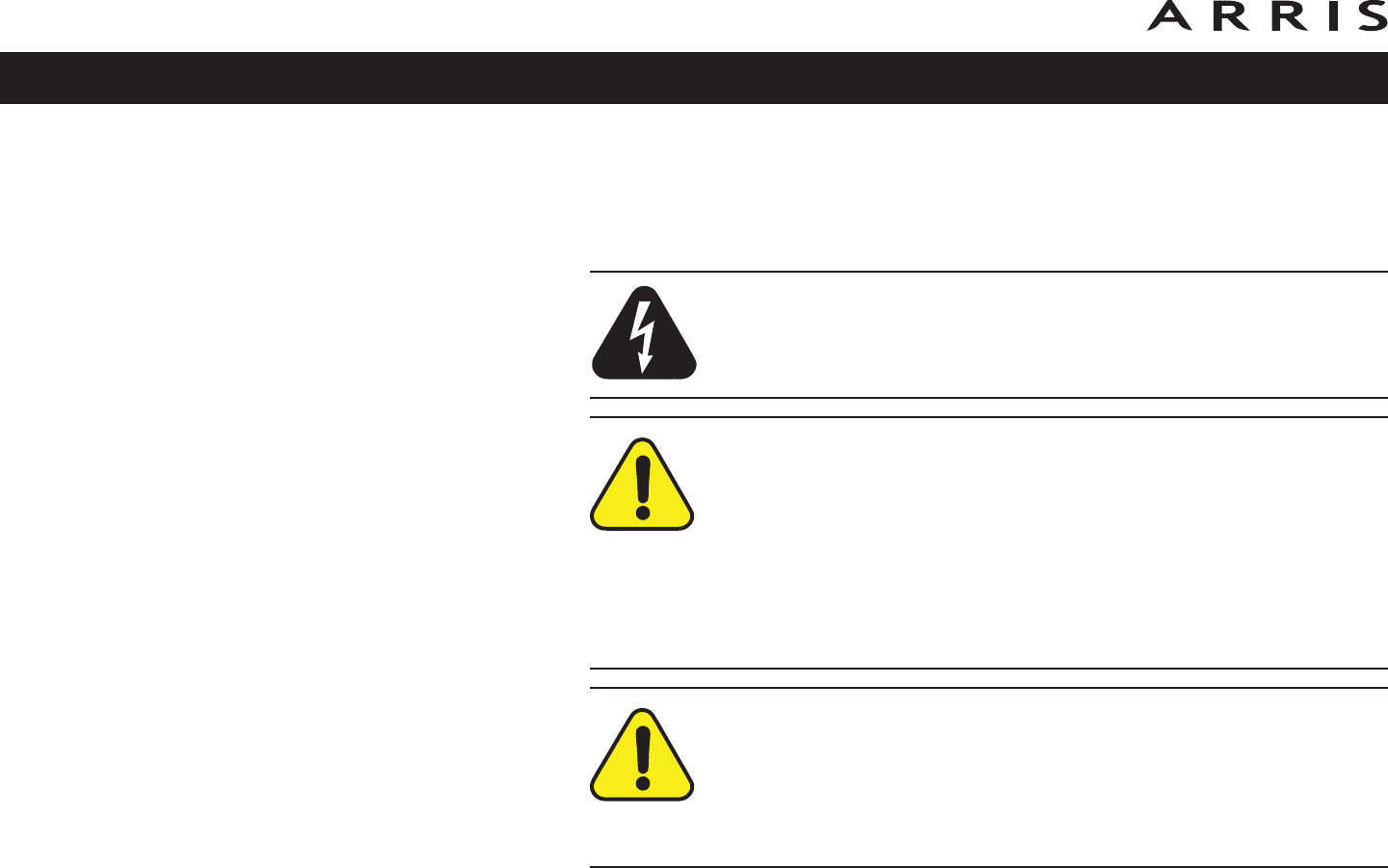
Safety Requirements
These Telephony Gateways comply with the applicable requirements for perform-
ance, construction, labeling, and information when used as outlined below:
CAUTION
Risk of shock
Mains voltages inside this unit. No user serviceable parts inside. Refer
service to qualified personnel only!
CAUTION
Potential equipment damage
Potential loss of service
Connecting the Telephony Gateway to existing telephone wiring should
only be performed by a professional installer. Physical connections to
the previous telephone provider must be removed and the wiring must
be checked; there must not be any voltages. Cancellation of telephone
service is not adequate. Failure to do so may result in loss of service
and/or permanent damage to the Telephony Gateway.
CAUTION
Risk of explosion
Replacing the battery with an incorrect type, heating a battery above
75°C, or incinerating a battery, can cause product failure and a risk of
fire or battery explosion. Do not dispose of in fire. Recycle or dispose
of used batteries responsibly and in accordance with local ordinances.
• The Telephony Gateway is designed to be connected directly to a telephone.
• Connecting the Telephony Gateway to the home’s existing tele phone wiring
should only be performed by a professional in staller.
• Do not use product near water (i.e. wet basement, bathtub, sink or near a
swimming pool, etc.), to avoid risk of electrocu tion.
Xfinity TG1682 Telephony Gateway User’s Guide
Safety
Getting
Started
Battery
Installation Installation
Ethernet
Configuration Usage Troubleshooting Glossary
3

• Do not use spray cleaners or aerosols on the Telephony Gateway.
• The product shall be cleaned using only a damp, lint-free, cloth. No sol-
vents or cleaning agents shall be used.
• Avoid using and/or connecting the equipment during an electri cal storm, to
avoid risk of electrocution.
• Do not use the telephone to report a gas leak in the vicinity of the leak.
• Do not locate the equipment within 6 feet (1.9 m) of a flame or ignition
source (i.e. heat registers, space heaters, fireplaces, etc.).
• Use only power supply and power cord included with the equip ment.
• Equipment should be installed near the power outlet and should be easily
accessible.
• The shield of the coaxial cable must be connected to earth (grounded) at the
entrance to the building in accordance with applicable national electrical in-
stallation codes. In the U.S., this is required by NFPA 70 (National Electrical
Code) Article 820. In the European Union and in certain other countries,
CATV instal lation equipotential bonding requirements are specified in IEC
60728-11, Cable networks for television signals, sound signals and interac-
tive services, Part 11: Safety. This equipment is in tended to be installed in
accordance with the requirements of IEC 60728-11 for safe operation.
If the equipment is to be installed in an area serviced by an IT power line
network, as is found in many areas of Norway, spe cial attention should be
given that the installation is in accor dance with IEC 60728-11, in particular
Annex B and Figure B.4.
• In areas of high surge events or poor grounding situations and areas prone
to lightning strikes, additional surge protection may be required (i.e.
PF11VNT3 from American Power Conver sion) on the AC, RF, Ethernet and
Phone lines.
• When the Telephony Gateway is connected to a local computer through Eth-
ernet cables, the computer must be proper ly grounded to the building/res-
idence AC ground network. All plug-in cards within the computer must be
properly installed and grounded to the computer frame per the manufac-
turer’s specifications.
Xfinity TG1682 Telephony Gateway User’s Guide
Safety
Getting
Started
Battery
Installation Installation
Ethernet
Configuration Usage Troubleshooting Glossary
4

• Ensure proper ventillation. Position the Telephony Gateway so that air flows
freely around it and the ventillation holes on the unit are not blocked.
• Do not mount the Telephony Gateway on surfaces that are sensitive to heat
and/or which may be damaged by the heat generated by the modem, its
power supply, or other accessories.
FCC Part 15
This equipment has been tested and found to comply with the requirements for a
Class B digital device under Part 15 of the Federal Communications Commission
(FCC) rules. These requirements are intended to provide reasonable protection
against harmful interference in a residential installation. This equipment generates,
uses and can radiate radio frequency energy and, if not installed and used in ac-
cordance with the instructions, may cause harmful interference to radio communi-
cations. However, there is no guarantee that interference will not occur in a
particular installation. If this equipment does cause harmful interference to radio or
television reception, which can be determined by turning the equipment off and on,
the user is encouraged to try to correct the interference by one or more of the fol-
lowing measures:
• Reorient or relocate the receiving antenna.
• Increase the separation between the equipment and receiver.
• Connect the equipment into an outlet on a circuit different from that to which
the receiver is connected.
• Consult the dealer or an experienced radio/TV technician for help.
Warning: Changes or modifications to this equipment not expressly approved by
the party responsible for compliance could void the user’s authority to operate the
equipment.
RF Exposure
This equipment complies with FCC radiation exposure limits set forth for an uncon-
trolled environment. This equipment should be installed and operated with mini-
mum distance of 7.9 inches (20cm) between the radiator and your body. This
transmitter must not be co-located or operating in conjunction with any other an-
tenna or transmitter.
Xfinity TG1682 Telephony Gateway User’s Guide
Safety
Getting
Started
Battery
Installation Installation
Ethernet
Configuration Usage Troubleshooting Glossary
5

Getting Started
About Your New Telephony Gateway
The Xfinity TG1682 Telephony Gateway is DOCSIS compliant with the following fea-
tures:
• Speed: much faster than dialup or ISDN service; up to eight times faster
than DOCSIS 2.0 cable modems.
• Convenience: supports Ethernet and 802.11a/b/g/n/ac wireless connec-
tions; both can be used simultaneously
• Flexibility: provides two independent lines of telephone service as well as
high speed data
• Compatibility:
– Data services: DOCSIS 3.0 compliant and backward-compatible with
DOCSIS 2.0 or 1.1; supports tiered data services (if offered by your
cable company)
– Telephony services: PacketCable™ 2.0 compliant
– DECT support for CAT-iq 2.0 compliant DECT 6.0 hardware with multi
line calling capabilities (if offered by your cable company)
The TG1682 provides:
• Wireless 802.11a/b/g/n/ac connectivity
• Four Ethernet ports for connections to non-wireless devices
• Up to two lines of telephone service with Digital Enhanced Cordless Telecom-
munications (DECT) funtionality
• Integrated MoCA 2.0 home networking
• DOCSIS 3.0 compliant with Li-Ion backup battery
• Two USB host ports (future support for external USB devices)
Xfinity TG1682 Telephony Gateway User’s Guide
Safety
Getting
Started
Battery
Installation Installation
Ethernet
Configuration Usage Troubleshooting Glossary
6
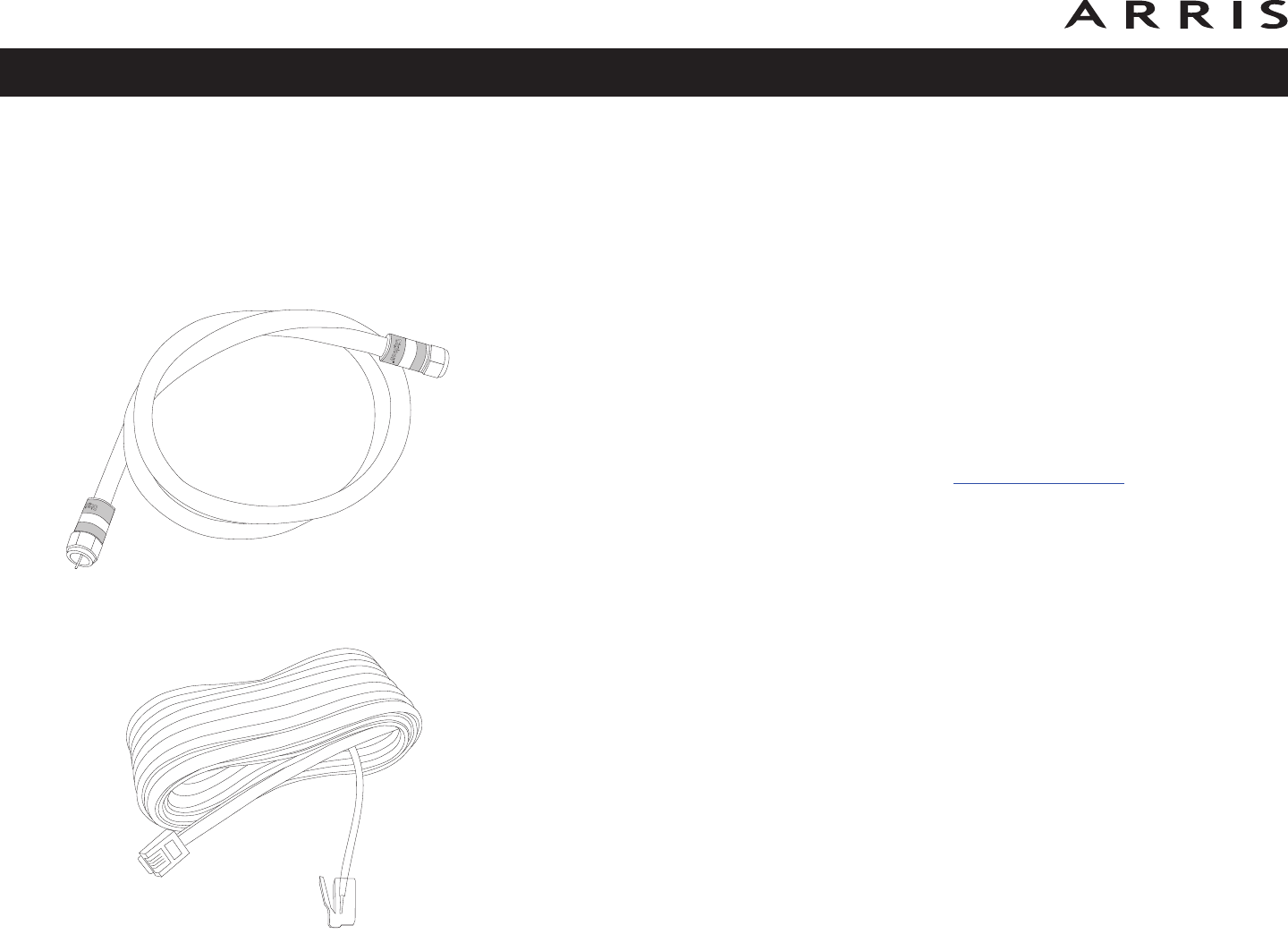
Coax Cable
7
Safety
Getting
Started
Battery
Installation Installation
Ethernet
Configuration Usage Troubleshooting Glossary
Xfinity TG1682 Telephony Gateway User’s Guide
What’s in the Box?
Make sure you have the following items before proceeding. Call your cable company
for assistance if anything is missing.
• Telephony Gateway
• Power Cord
• Quick Installation Guide
• End User License Agreement
Items You Need
If you are installing the Telephony Gateway yourself, make sure you have the fol-
low ing items on hand before continuing:
•Telephony Gateway package: see What’s in the Box? for a list of items
in the package.
•Coaxial cable (coax): as shown in the image to the left, this is a round
cable with a connector on each end. It is the same kind of wire used to con-
nect to your television for cable TV. You can buy coax from any electronics
retailer and many discount stores; make sure it has connectors on both
ends. There are two types of connectors, slip-on and screw-on; the screw-
on connectors are best for use with your Telephony Gateway. The coax
should be long enough to reach from your Telephony Gateway to the near-
est cable outlet.
Note: For best performance, use high-quality RG-6 type coax cable and mini-
mize or eliminate splitters between the cable jack and the Telephony Gateway.
•Phone Cable: as shown in the image to the left, this is a standard phone
cable with standard phone connectors (RJ11 type) on both ends. You can
buy phone cables from any electronics retailer and many discount stores.
•Splitter (optional): provides an extra cable connection by splitting a sin-
gle outlet into two. You may need a splitter if you have a TV already con-
nected to the cable outlet that you want to use. You can buy a splitter from
any electronics retailer and most discount stores; you may also need a short
piece of coax cable (with connectors); use it to connect the splitter to the
cable outlet and then connect the Telephony Gateway and TV to the splitter.
Phone Cable

Note: A splitter effectively cuts the signal in half and sends each half to its
two outputs. Using several splitters in a line may deteriorate the quality of
your television, telephone, and/or internet connection.
•Ethernet Cable(s): as shown in the image to the left, this is a Category 5e
(CAT5e) straight-through cable for connecting computers to the Gateway.
•Information packet: your cable company should furnish you with a packet
containing information about your service and how to set it up. Read this in-
formation carefully. Contact your cable company if you have any ques tions.
Getting Service
Before trying to use your new Telephony Gateway, contact your local cable company
to establish an Internet account and telephone service. When you call, have the
fol lowing information ready:
• the Telephony Gateway serial number and cable MAC addresses of the unit
(printed on the back panel of the Telephony Gateway)
• the model number of the Telephony Gateway (printed on the bottom panel
of the Telephony Gateway)
If the Telephony Gateway was provided by your cable company, they already have
the required information.
In addition, you should ask your cable company the following questions:
• Do you have any special system requirements or files that I need to down-
load after I am connected?
• When can I start using my Telephony Gateway?
• Do I need a user ID or password to access the Internet or my e-mail?
• Will my phone number(s) change?
• What new calling features will I have and how do I use them?
Xfinity TG1682 Telephony Gateway User’s Guide
Safety
Getting
Started
Battery
Installation Installation
Ethernet
Configuration Usage Troubleshooting Glossary
8
Ethernet Cable

9
Safety
Getting
Started
Battery
Installation Installation
Ethernet
Configuration Usage Troubleshooting Glossary
Xfinity TG1682 Telephony Gateway User’s Guide
System Requirements
The Telephony Gateway operates with most computers. The following describes re-
quirements for each operating system; see the documentation for your system for
details on enabling and configuring networking.
To use the Telephony Gateway, you need DOCSIS high-speed Internet service from
your cable company. Telephone service requires that the cable company has Pack-
etCable support.
Recommended Hardware
The following hardware configuration is recommended. Computers not meeting this
configuration can still work with the TG1682, but may not be able to make maxi-
mum use of TG1682 throughput.
• CPU: P4, 3GHz or faster
• RAM: 1GB or greater
• Hard drive: 7200 RPM or faster
• Ethernet: Gig-E (1000BaseT)
Windows
Windows XP, Windows Vista, Windows 7, or Windows 8. A supported Ethernet or
wireless LAN connection must be available.
MacOS
System 7.5 to MacOS 9.2 (Open Transport recommended) or MacOS X. A supported
Ethernet or wireless LAN connection must be available.
Linux/other Unix
Hardware drivers, TCP/IP, and DHCP must be enabled in the kernel. A supported
Ethernet or wireless LAN connection must be available.
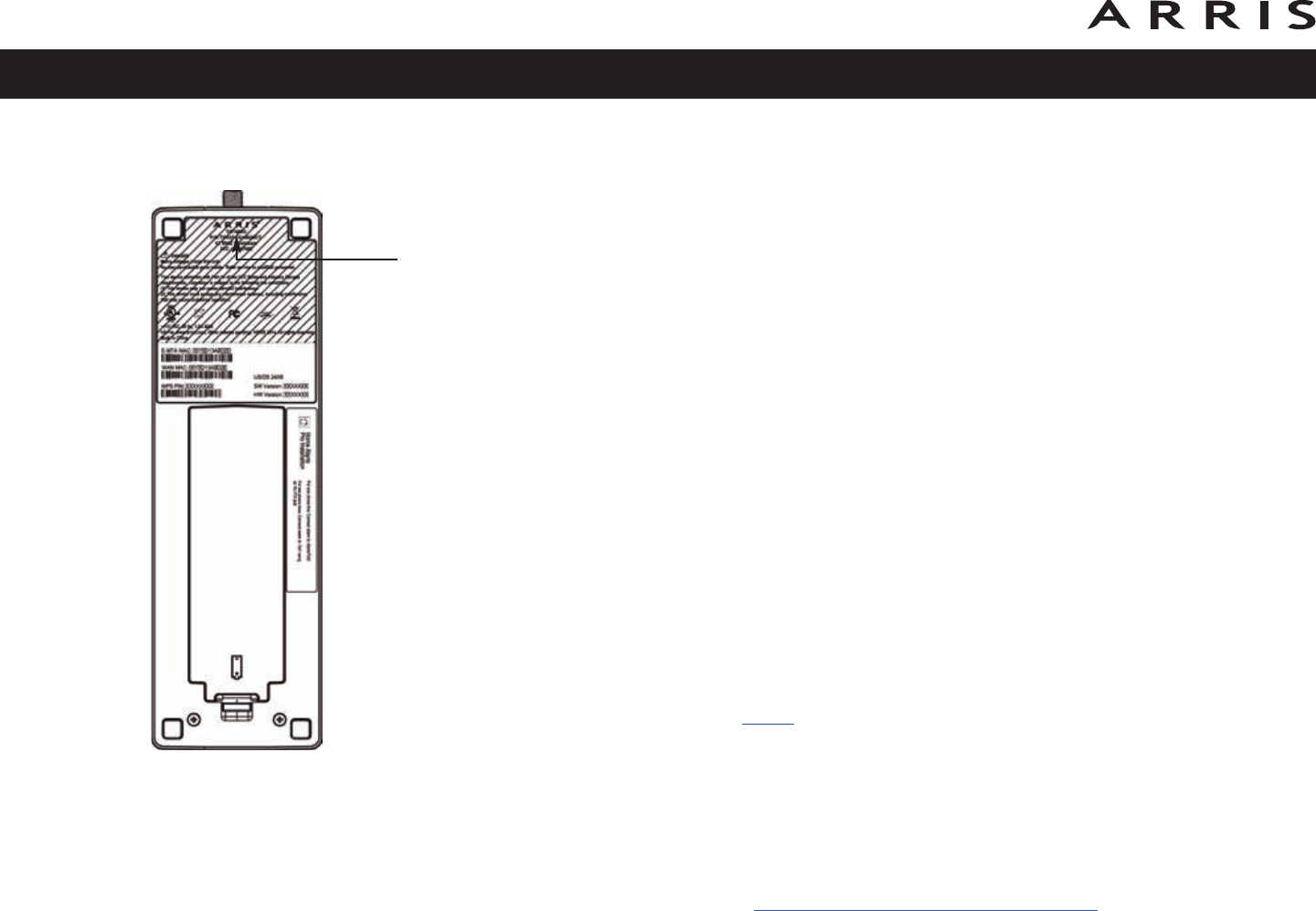
About this Manual
This manual covers the Xfinity TG1682 Telephony Gateway. The model number is
on the label affixed to the bottom of the Telephony Gateway. See the image at the
left.
What About Security?
Having a high-speed, always-on connection to the Internet requires a certain
amount of responsibility to other Internet users—including the need to maintain a
reasonably secure system. While no system is 100% secure, you can use the fol-
lowing tips to enhance your system’s security:
• Keep the operating system of your computer or laptop updated with the lat-
est security patches. Run the system update utility at least weekly.
• Keep your email program updated with the latest security patches. In addi-
tion, avoid opening email containing attachments, or opening files sent
through chat rooms, whenever possible.
• Install a virus checker and keep it updated.
• Avoid providing web or file-sharing services over your Telephony Gateway.
Besides certain vulnerability problems, most cable companies prohibit run-
ning servers on consumer-level accounts and may suspend your account for
violating your terms of service.
• Use the cable company’s mail servers for sending email.
• Avoid using proxy software unless you are certain that it is not open for
abuse by other Internet users (some are shipped open by default). Crimi-
nals can take advantage of open proxies to hide their identity when break-
ing into other computers or sending spam. If you have an open proxy, your
ca ble company may suspend your account to protect the rest of the net-
work.
• If you use the wireless LAN, make sure you enable wireless security on the
Telephony Gateway (for the same reasons that you should run only secured
proxies). See Configuring Your Wireless Connection.
Xfinity TG1682 Telephony Gateway User’s Guide
Safety
Getting
Started
Battery
Installation Installation
Ethernet
Configuration Usage Troubleshooting Glossary
10
Model
Number
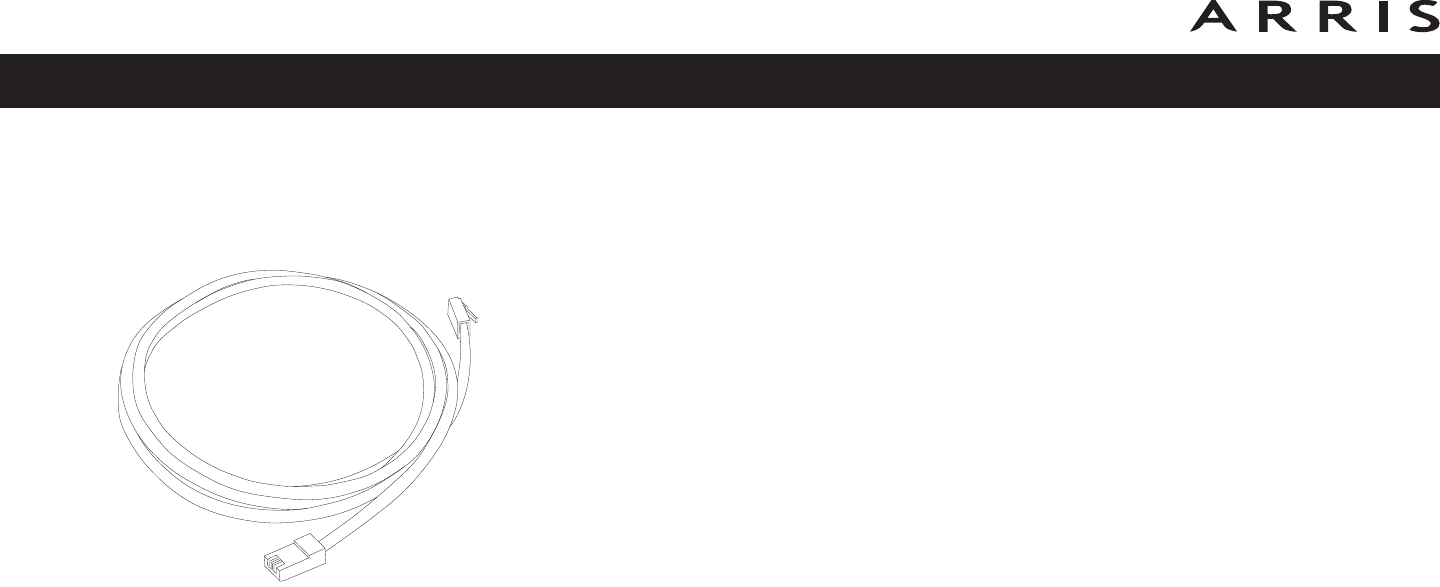
Ethernet Cable
11
Safety
Getting
Started
Battery
Installation Installation
Ethernet
Configuration Usage Troubleshooting Glossary
Xfinity TG1682 Telephony Gateway User’s Guide
Ethernet or Wireless?
There are two ways to connect your computer (or other equipment) to the Tele-
phony Gateway. The following will help you decide which is best for you:
Ethernet
Ethernet is a standard method of connecting two or more computers into a Local
Area Network (LAN). You can use the Ethernet connection if your computer has
built-in Ethernet hardware.
Note: To connect more than four computers to the TG1682 through the Ether-
net ports, you need an Ethernet hub (available at computer retail ers).
The Telephony Gateway comes with one 4-foot (1.2m) Ethernet cable (the connec-
tors look like wide telephone connectors); you can purchase more cables if neces-
sary at a computer retailer. If you are connecting the Telephony Gateway directly
to a computer, or to an Ethernet hub or broadband router with a cross-over switch,
ask for Category 5e (CAT5e) straight-through cable. CAT5e cable is required for gi-
gabit Ethernet (Gig-E), not regular CAT5 cable
Wireless
Wireless access lets you connect additional (wireless-capable) devices to Telephony
Gateway. The 802.11 wireless LAN standard allows one or more computers to ac-
cess the TG1682 using a wireless (radio) signal. These connections are in addition
to the connections supported via Ethernet.
Note: You can use the wireless connection if your computer has a built-in or af-
termarket plug-in wireless adapter. To learn more about which wireless
hardware works best with your com puter, see your computer dealer.
Both
If you have two or more computers, you can use Ethernet for up to four devices and
wireless for the others. To connect five or more computers to the Ethernet ports,
you will need an Ethernet hub (available at computer retailers.)
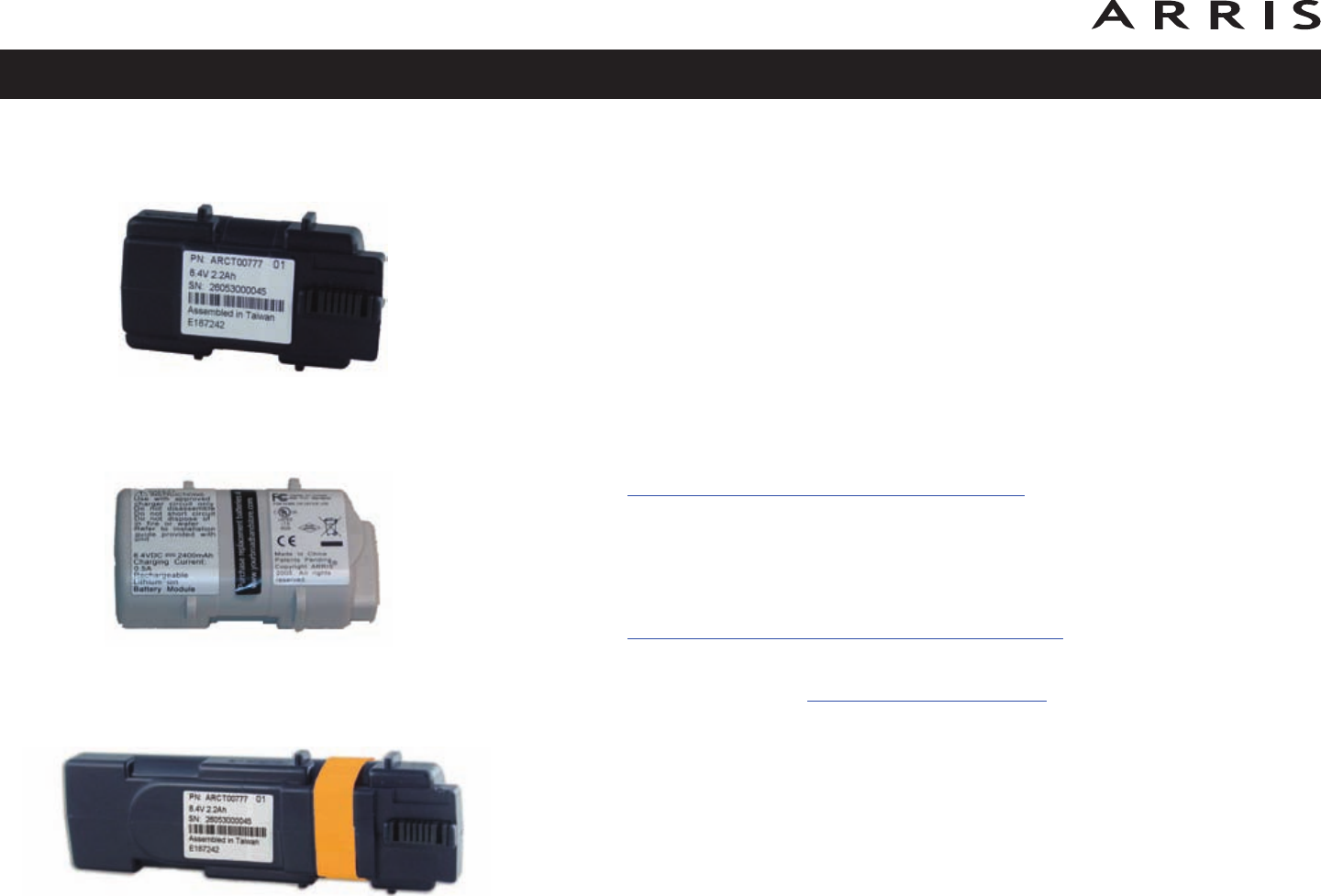
Battery Installation and Removal
The TG1682 Telephony Gateway supports a Lithium-Ion backup battery to provide
continued telephone service during power outages. The battery backup is not in-
tended to take the place of AC power.
Note: For safety and regulatory purposes, batteries are shipped outside of the
Telephony Gateway and must be installed.
The TG1682 supports the following battery models:
•Basic backup battery — provides up to 4 hours of backup time, depend-
ing on your Telephony Gateway model and usage. It may be light grey or
black.
Basic Battery Installation and Replacement
•Extended backup battery — provides up to 8 hours of backup time, de-
pending on model and usage. It has a strap between the battery guides.
This is the standard battery for the TG1682.
Extended Battery Installation and Replacement
Your cable company may include a backup battery with your Telephony Gateway.
You can order batteries at www.arrsimodemsite.com
Xfinity TG1682 Telephony Gateway User’s Guide
Safety
Getting
Started
Battery
Installation Installation
Ethernet
Configuration Usage Troubleshooting Glossary
12
Basic Backup Battery (black)
Basic Backup Battery (grey)
Extended Backup Battery
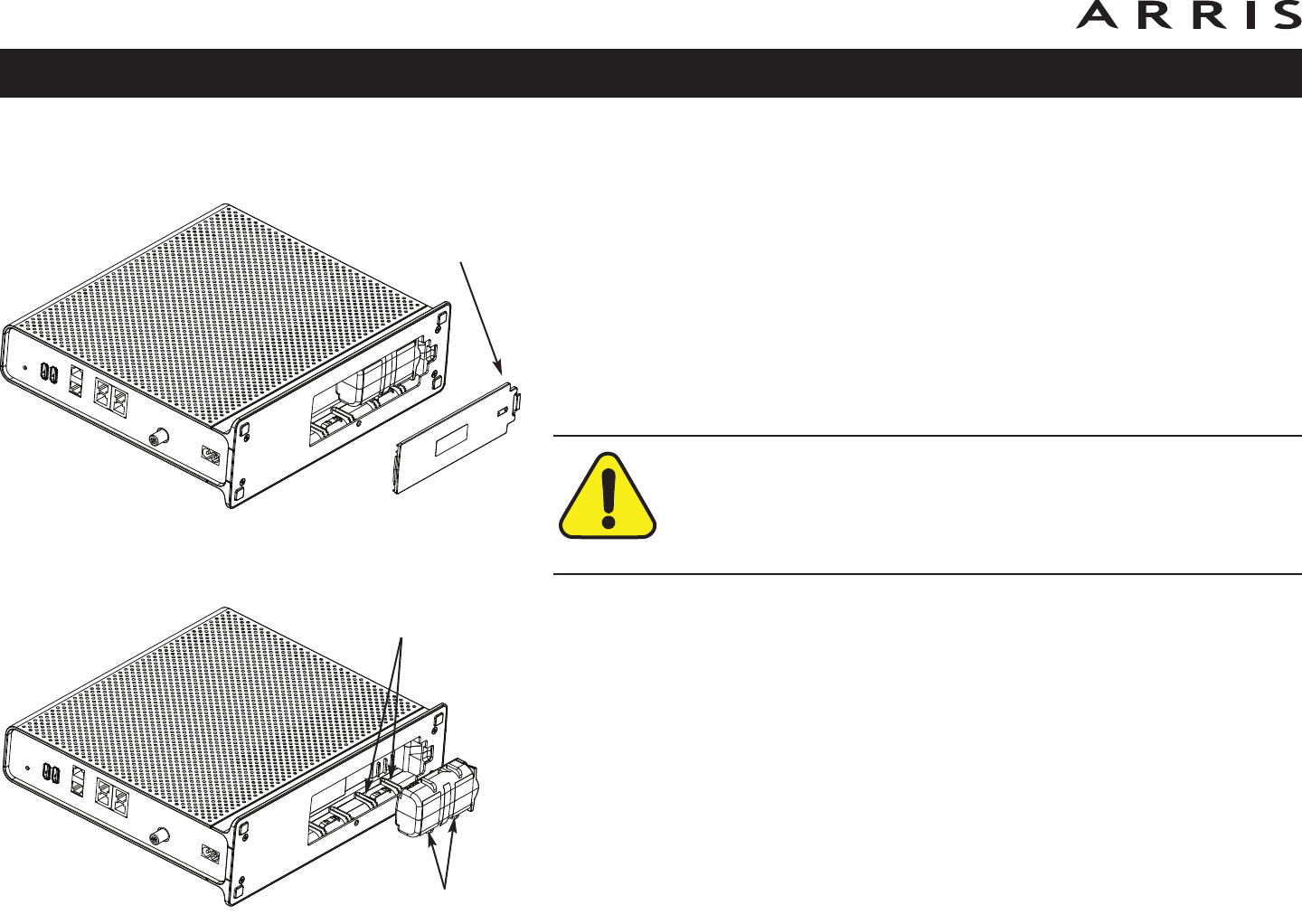
Basic Battery Installation and Replacement
This model of the Telephony Gateway supports backup batteries to provide contin-
ued telephone service during power outages. The battery backup is not intended to
take the place of AC power.
Use this procedure to install and to replace the backup battery.
1Press down and pull back on the latch holding the battery door (on the bot-
tom of the Telephony Gateway). Pull the door toward you. Set the door aside
in a safe place.
CAUTION
Risk of equipment damage
Improperly inserting the battery may damage the battery connector in
the Telephony Gateway. Carefully follow the instructions in the next
step to avoid damage.
2Hold the battery pack so that the guides on the battery align with the slots
on the Telephony Gateway and slide the battery into the bay. The diagram
on the left shows the proper orientation.
Note: Batteries will not insert completely into the Telephony Gateway if not
oriented correctly. The battery should slide into the bay without significant
force. Line up the guides on the battery with the slots in the battery bay.
Xfinity TG1682 Telephony Gateway User’s Guide
Safety
Getting
Started
Battery
Installation Installation
Ethernet
Configuration Usage Troubleshooting Glossary
13
Latch End
Battery Slots
Battery Guides
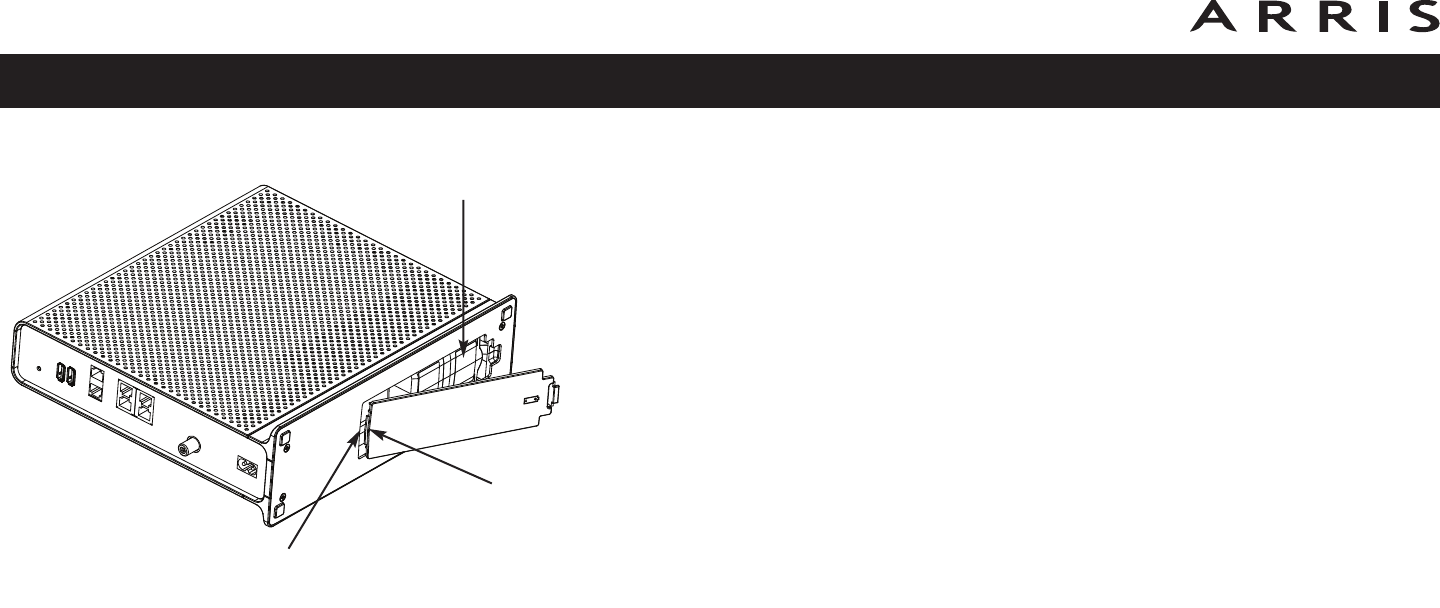
3Push the battery pack into the bay until it seats into place. If you are tak-
ing the battery out of the Telephony Gateway, position your finger
in the battery opening area and use leverage to dislodge the battery
while pulling it straight back.
Note: The Telephony Gateway will not begin operating until you apply AC
power.
4Replace the door. To do so, place the hinge tab of the battery door into the
receiver slot inside the Telephony Gateway battery compartment on the
opposite end of the battery opening. Rotate the door toward the unit until
the latch snaps back into place.
Note: Telephony Gateways use a Lithium-Ion battery pack. Please recycle
or dispose of the battery responsibly and in accordance with local ordi-
nances.
Xfinity TG1682 Telephony Gateway User’s Guide
Safety
Getting
Started
Battery
Installation Installation
Ethernet
Configuration Usage Troubleshooting Glossary
14
Battery
Compartment
Receiver
Slot
Hinge Tab
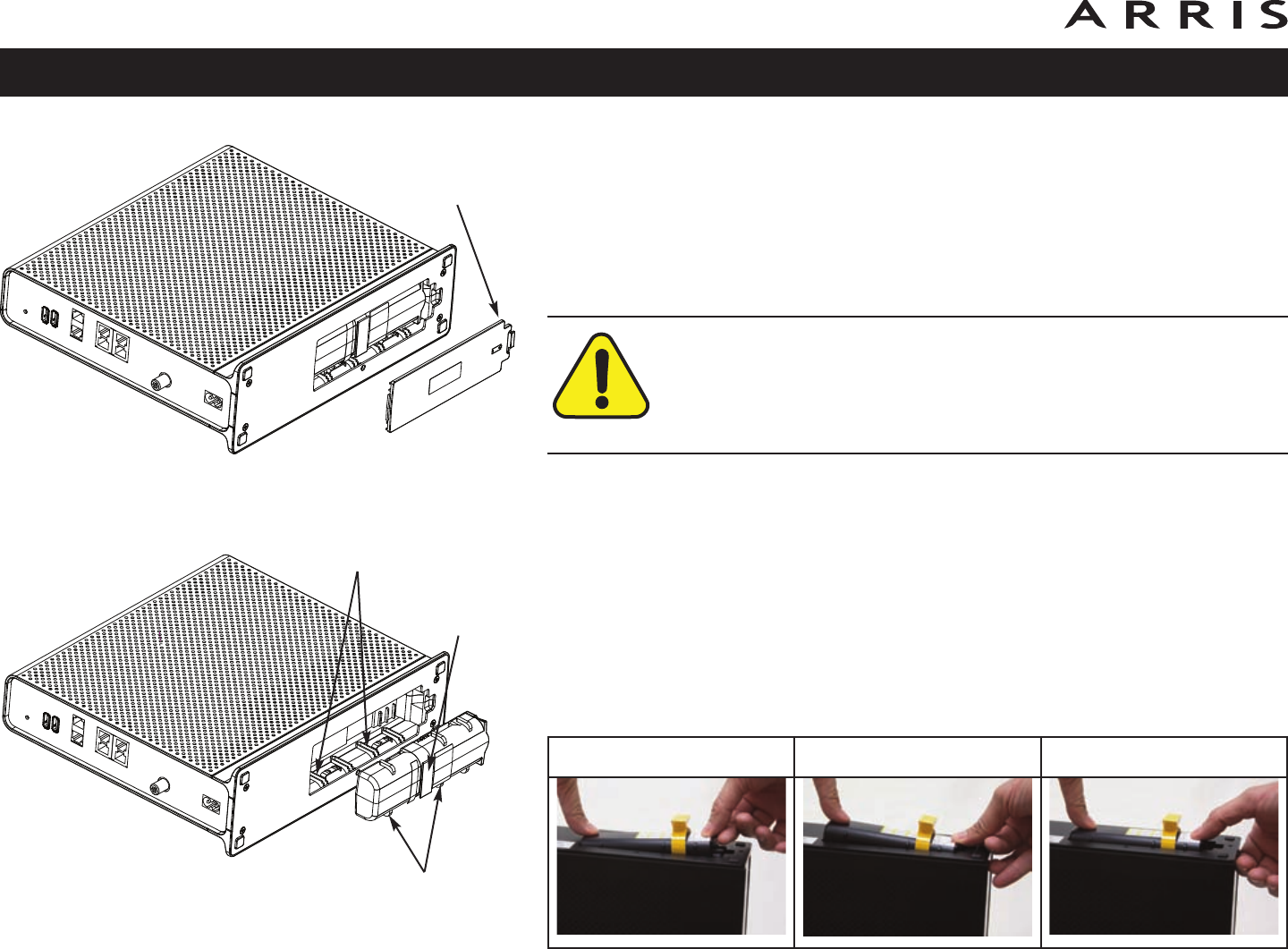
Extended Battery Installation and Replacement
Use this procedure to install or replace the backup battery.
1Press down and pull back on the latch holding the battery door (on the bot-
tom of the Telephony Gateway). Pull the door toward you. Set the door aside
in a safe place.
CAUTION
Risk of equipment damage
Improperly inserting the battery may damage the battery connector in
the Telephony Gateway. Carefully follow the instructions in the next
step to avoid damage.
2Hold the battery pack so that the guides on the battery align with the slots
on the Telephony Gateway and slide the battery into the bay. The diagram
on the left shows the proper orientation.
Note: Batteries will not insert completely into the Telephony Gateway if not
oriented correctly. The battery should slide into the bay without significant
force. Line up the slots in the battery bay with the guides on the battery
and apply even pressure on both ends of the battery.
Xfinity TG1682 Telephony Gateway User’s Guide
Safety
Getting
Started
Battery
Installation Installation
Ethernet
Configuration Usage Troubleshooting Glossary
15
Battery
Pull Strap
WRONG WRONG RIGHT
Latch End
Battery Guides
Battery Slots
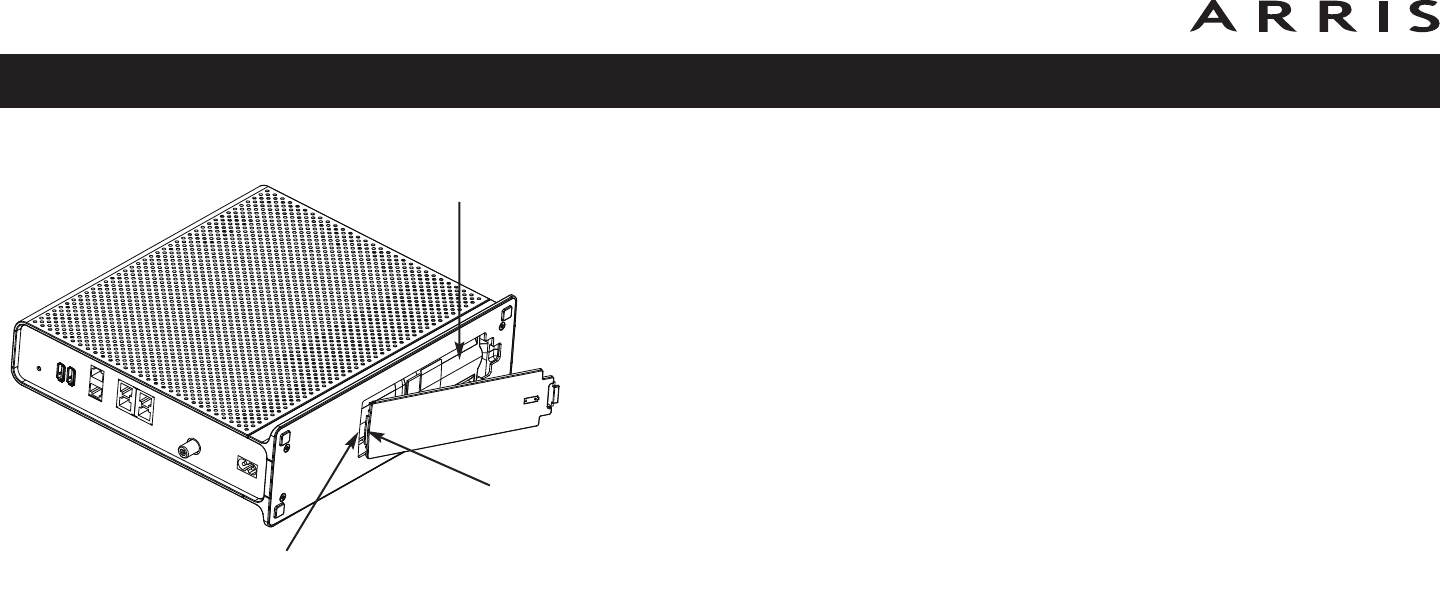
3Push the battery pack into the bay until it latches into place. If you are
taking the battery out of the Telephony Gateway, use the battery
pull strap to dislodge the battery.
Note: The Telephony Gateway will not begin operating until you apply AC
power.
4Replace the door. To do so, place the tab of the battery door into the slot in-
side the Telephony Gateway battery compartment. Rotate the door toward
the front of the Telephony Gateway until the latch snaps back into place.
Note: Telephony Gateways use a Lithium-Ion battery pack. Please recycle
or dispose of the battery responsibly and in accordance with local ordi-
nances.
Xfinity TG1682 Telephony Gateway User’s Guide
Safety
Getting
Started
Battery
Installation Installation
Ethernet
Configuration Usage Troubleshooting Glossary
16
Battery
Compartment
Receiver
Slot
Hinge Tab
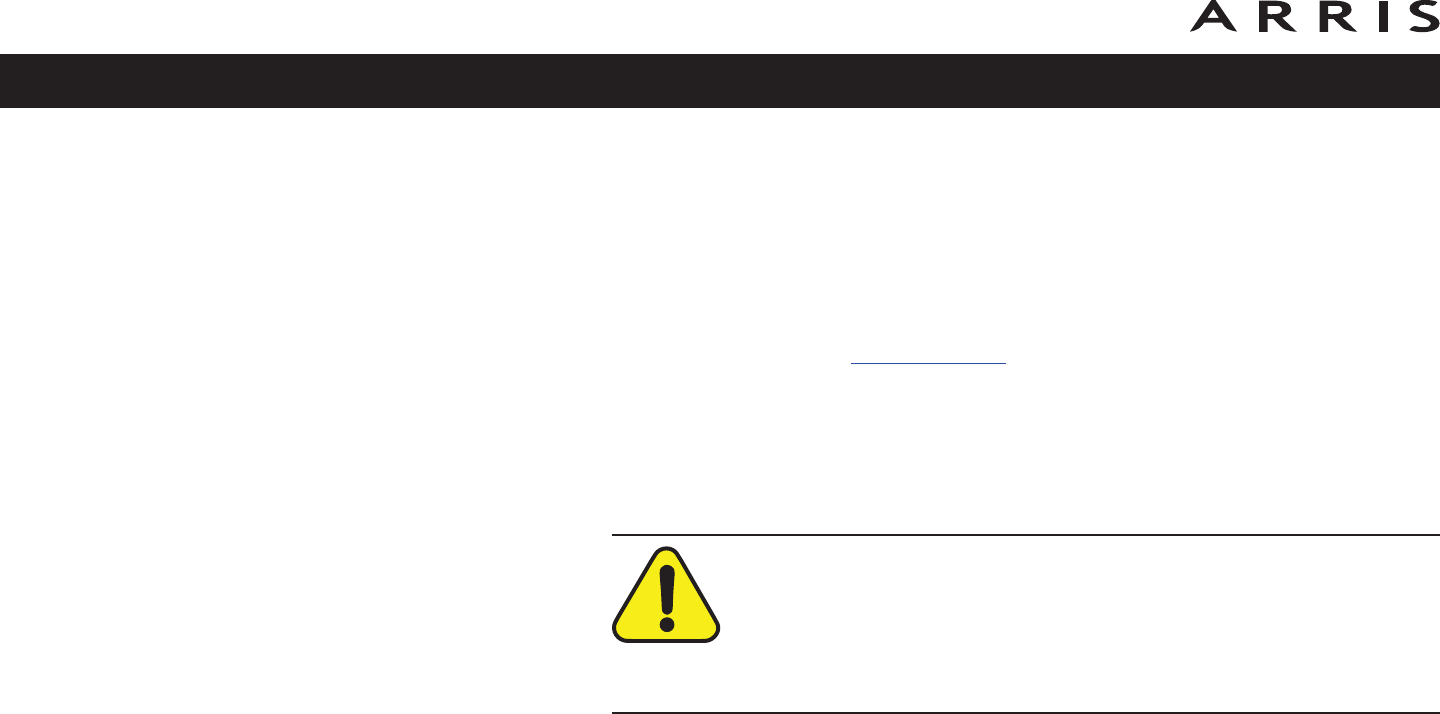
Installing and Connecting Your
Telephony Gateway
Before you start, make sure that:
• You have contacted your cable company and verified that they provide data
and telephone service using standard DOCSIS technology.
• You have all the items you need.
• Cable, phone, and power outlets are available near the computer. If a cable
outlet is not conveniently located, your cable company can install a new one.
If you have ordered service, your cable company should configure the Telephony
Gateway automatically. You need only follow the instructions in this section to in-
stall and connect the Telephony Gateway.
CAUTION
Risk of equipment damage
Only qualified installation technicians should connect the Telephony
Gateway to house wiring. Incumbent telephone service must be physi-
cally disconnected at the outside interface box before making any
connections.
Xfinity TG1682 Telephony Gateway User’s Guide
Safety
Getting
Started
Battery
Installation Installation
Ethernet
Configuration Usage Troubleshooting Glossary
17
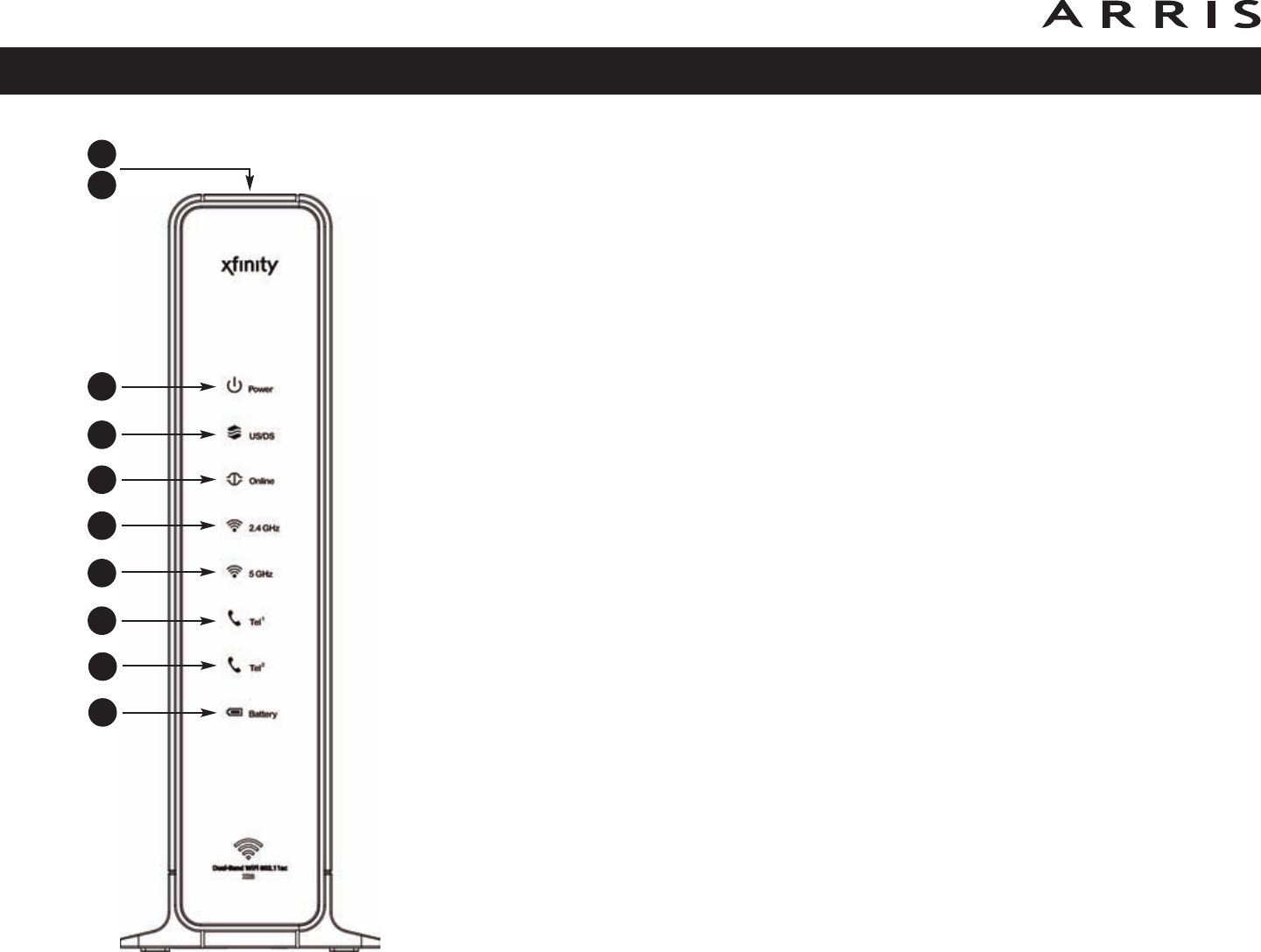
B
E
C
A
D
F
H
G
18
Safety
Getting
Started
Battery
Installation Installation
Ethernet
Configuration Usage Troubleshooting Glossary
Xfinity TG1682 Telephony Gateway User’s Guide
Front Panel
The front of the Telephony Gateway has the following indicators:
A WPS button with indicator light: indicates Wireless Protected Setup (WPS)
is active. (Button with light ring is located on top of unit.)
B DECT button with indicator light: Pressing the button pages all the regis-
tered handsets. Pressing again cancels paging. Pressing and holding the but-
ton for 15 seconds places the unit in registration mode for handset
registration. (Button with light ring is located on top of unit.)
Note: The DECT button only works with CAT-iq 2.0 cordless handsets.
C Power: indicates whether AC power is available to the unit.
D US/DS: indicates upstream and downstream connectivity.
E Online: indicates Internet data transmission status.
F 2.4 GHz: indicates the status of the 2.4 GHz wireless LAN.
G 5 GHz: indicates the status of the 5GHz wireless LAN.
H Tel 1: indicates the status of telephone line 1.
I Tel 2: indicates the status of telephone line 2.
J Battery: indicates the battery status.
J
I
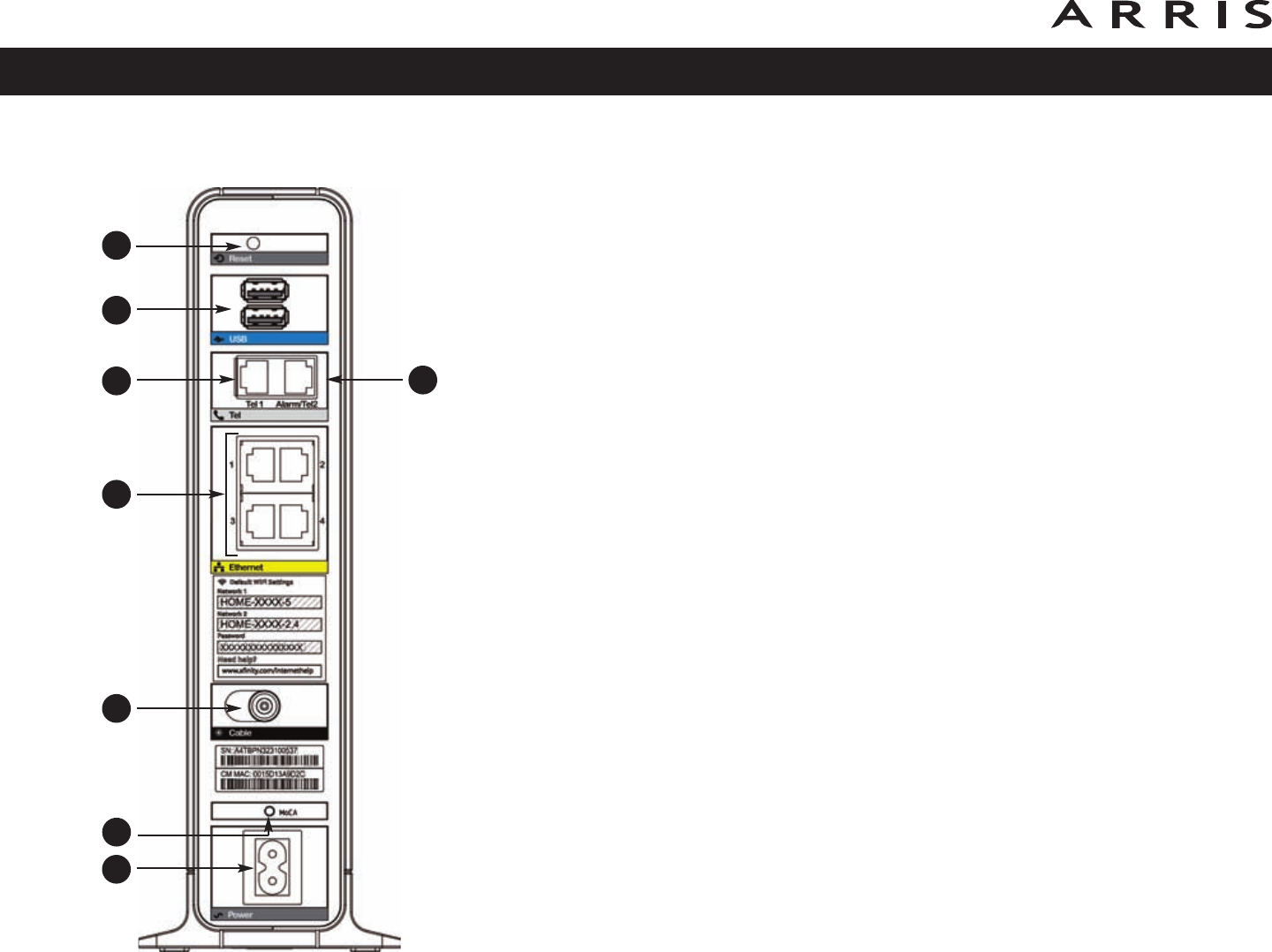
Rear Panel
The rear of the Telephony Gateway has the following connectors and controls:
A Reset button: resets the Telephony Gateway as if you power cycled the unit.
Use a pointed non-metallic object to press this button.
B USB: USB host connectors - future support for external USB devices
C Tel 1: connector for the first phone line.
D Alarm/Tel 2: connector for the second phone line or a home alarm con-
nection.
E Ethernet (1 - 4): connectors for use with a computer LAN port.
F Cable: connector for the coaxial cable.
G MoCA: indicates connectivity between the Telephony Gateway and other
home devices connected via the MoCA network.
H Power: connector for the power cord.
Xfinity TG1682 Telephony Gateway User’s Guide
Safety
Getting
Started
Battery
Installation Installation
Ethernet
Configuration Usage Troubleshooting Glossary
19
B
E
C
A
D
F
H
G

Selecting an Installation Location
There are a number of factors to consider when choosing a location to install your
Telephony Gateway:
• Is an AC outlet available nearby? For best results, the outlet should not be
switched and should be close enough to the Telephony Gateway that exten-
sion cords are not required.
• Is a cable jack available? For best performance, keep the number of split-
ters between the jack and cable drop to a minimum. Each splitter attenuates
(re duces) the signal available to the Telephony Gateway. A large number of
split ters can slow down the Internet connection and even affect your tele-
phone service.
• Can you easily run cables between the Telephony Gateway’s location and
the phones?
• If you are connecting devices to the Ethernet ports, can you easily run ca-
bles between the Telephony Gateway’s location and those devices?
• If you want to install the Telephony Gateway on a desktop, is there enough
space on either side to keep the vents clear? Blocking the vents may cause
overheating.
• How close are your wireless devices? The Telephony Gateway wireless con-
nection range is typically 100–200 feet (30m–65m). A number of factors
can affect connection range, as described below.
Desktop mounting instructions
Position the Telephony Gateway so that:
• air flows freely around it
• the back faces the nearest wall
• it will not fall to the floor if bumped or moved
• the side of the unit are not blocked.
Xfinity TG1682 Telephony Gateway User’s Guide
Safety
Getting
Started
Battery
Installation Installation
Ethernet
Configuration Usage Troubleshooting Glossary
20
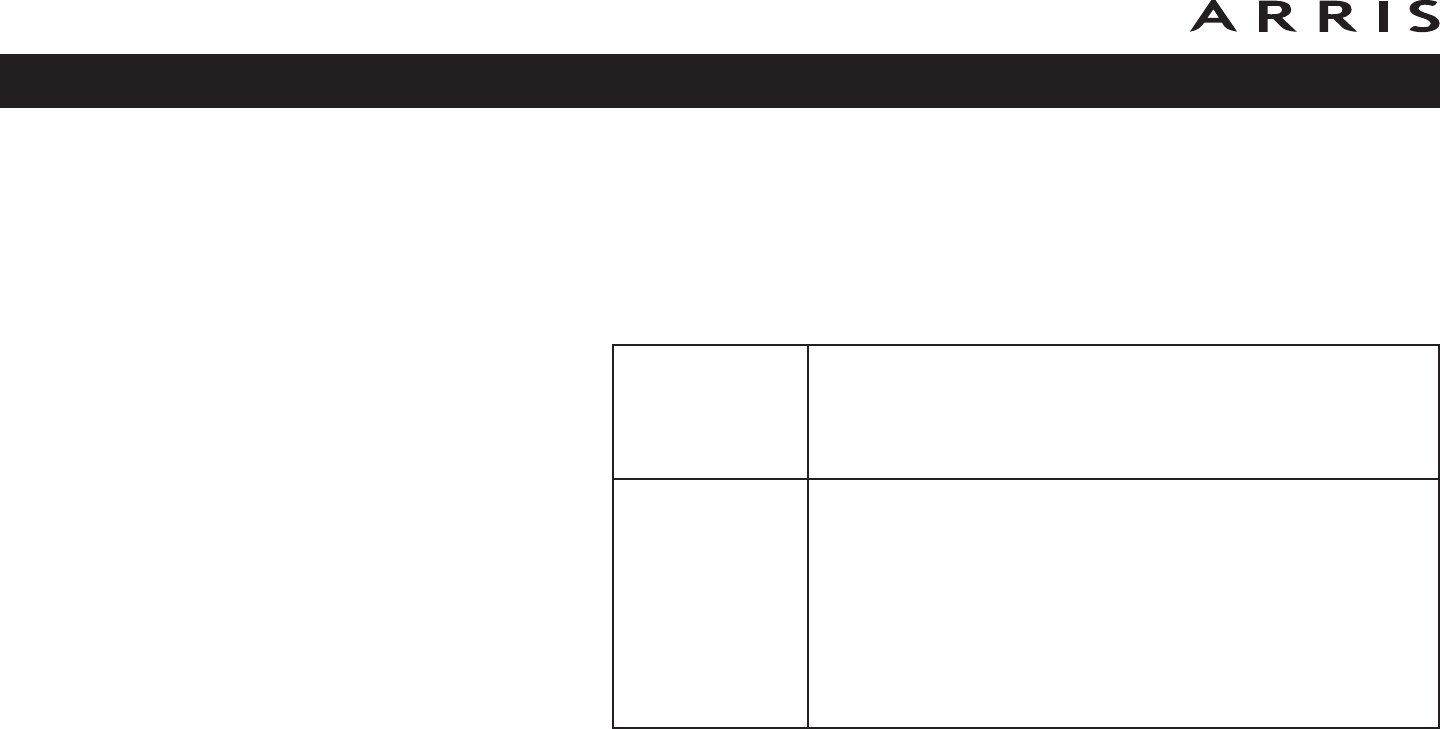
Cleaning Instructions
Clean the Telephony Gateway using only a clean, slightly moistened, cloth. Do not
use aerosols in the vicinity of the Telephony Gateway.
Factors Affecting Wireless Range
A number of factors can affect the usable range for wireless connections.
Note: Decreasing the range of your wireless network may be beneficial, as long
as the decreased range is sufficient for your needs. By limiting your net-
work’s range, you reduce interference with other networks and make it
harder for unwant ed users to find and connect to your network.
Note: Setting the trasmit power level to High increases the range. Setting it
to Medium or Low decreases the range proportionately.
Increases range: • Raising the unit above the devices (for example, in-
stalling the Telephony Gateway in the upper floor of a
multi-story dwelling)
• Adding a wireless extender to the network
Decreases range: • Lowering the unit below the devices (for example, in-
stalling the Telephony Gateway in a basement)
• Metal or concrete walls between the Telephony Gate-
way and other devices
• Large metal appliances, aquariums, or metal cabinets
between the Telephony Gateway and other devices
• Interference and RF noise (2.4 GHz wireless phones,
microwave ovens, or other wireless networks)
Xfinity TG1682 Telephony Gateway User’s Guide
Safety
Getting
Started
Battery
Installation Installation
Ethernet
Configuration Usage Troubleshooting Glossary
21
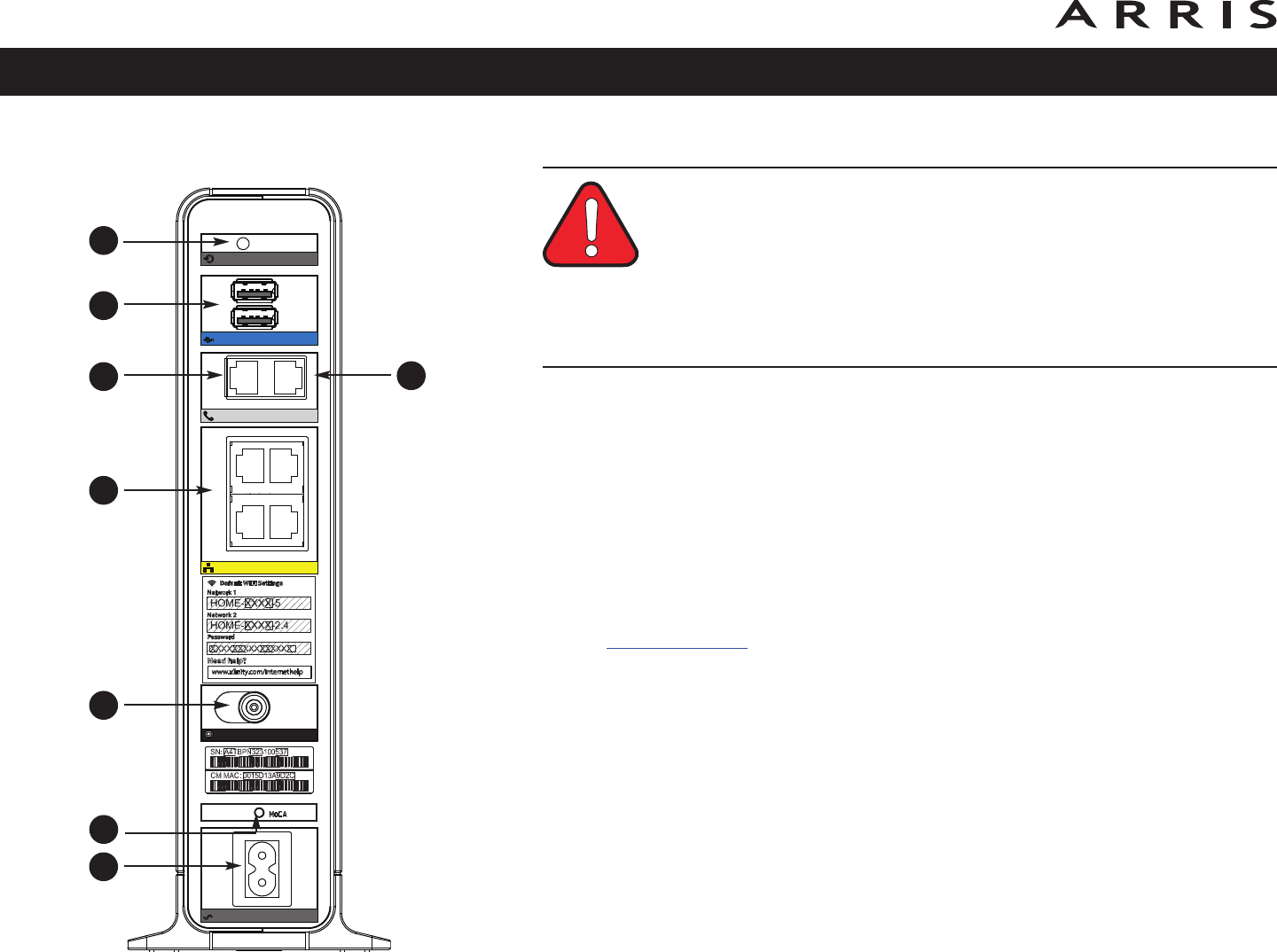
Connecting the Telephony Gateway
WARNING
Risk of injury or equipment damage
Connecting the Telephony Gateway to the home’s existing telephone
wiring should only be performed by a professional installer. Physical con-
nections to the previous telephone provider must be removed and the
wiring must be checked; there must not be any voltage. Cancellation of
telephone service is not adequate. Failure to do so may result in loss of
service and/or permanent damage to the Telephony Gateway.
1Connect one end of the coax cable to the cable outlet or splitter, and the
other end to the Telephony Gateway’s Cable connector (F). Tighten the con-
nections by hand, then tighten an additional 1/8 turn with a wrench.
Note: For best performance, use high-quality coax cable and minimize or
eliminate splitters between the cable jack and the Telephony Gateway.
2Insert the plug from the power cord into the Power connector on the back
of the Telephony Gateway (H) and insert the power cord into a convenient
AC outlet.
The Power light on the front of the Telephony Gateway lights up, then flashes
once (refer to the LED tables shown in Using the Telephony Gateway). See
Troubleshooting if the Power light does not turn on.
3Connect one end of the Ethernet cable to any Ethernet port on the back of
the Telephony Gateway, (E) and the other end to the Ethernet port on a
com puter, hub, or broadband router.
Note: If you are connecting to a computer or an Ethernet hub with a cross-
over switch, use a straight-through cable.
4Connect one end of the telephone cable to the telephone port on the back
of the Telephony Gateway (Cor D). Connect the other end to the telephone.
Home Alarm Connection
The Alarm port (D) is for use with an analog home alarm system or for a sec-
ond phone line. Only a trained professional (Comcast or alarm installer)
should use this port.
Xfinity TG1682 Telephony Gateway User’s Guide
Safety
Getting
Started
Battery
Installation Installation
Ethernet
Configuration Usage Troubleshooting Glossary
22
Reset
USB
Tel
Tel 1 Alarm/Tel2
12
34
Ethernet
Cable
Power
B
E
C
A
D
F
H
G
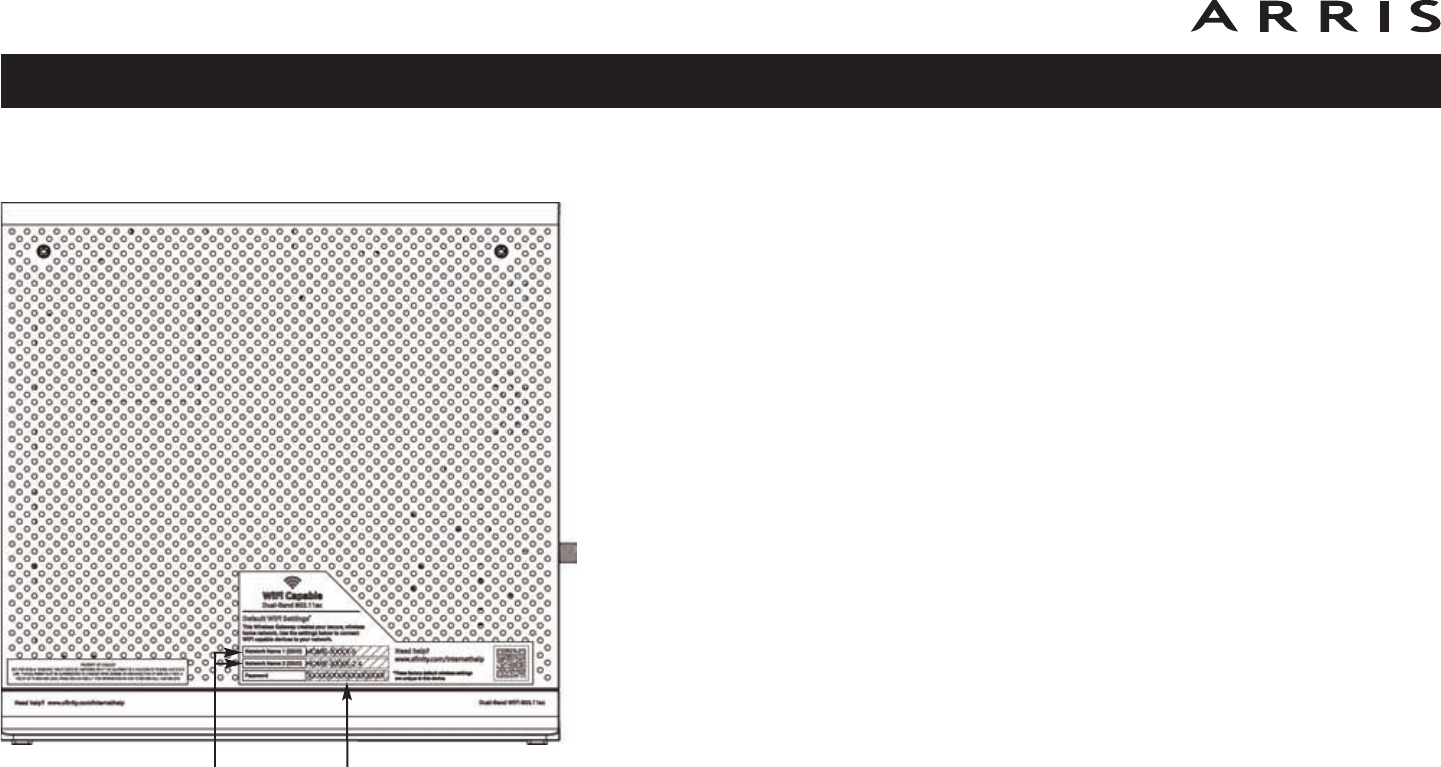
Configuring Your Wireless Connection
The TG1682 ships with a secure SSID that is unique for every device. Wi-Fi network
information is located on the side panel label. If your computer is equipped with a
802.11a/b/g/n/ac wireless LAN card, you may wish to configure the Telephony
Gateway’s wireless settings.
Note: At a minimum, you should set a login password and set up wire-
less security. Refer to the separate wireless configuration documenta-
tion for complete instructions on configuring your wireless connection.
Xfinity TG1682 Telephony Gateway User’s Guide
Safety
Getting
Started
Battery
Installation Installation
Ethernet
Configuration Usage Troubleshooting Glossary
23
Network
Names
(SSIDs)
Password
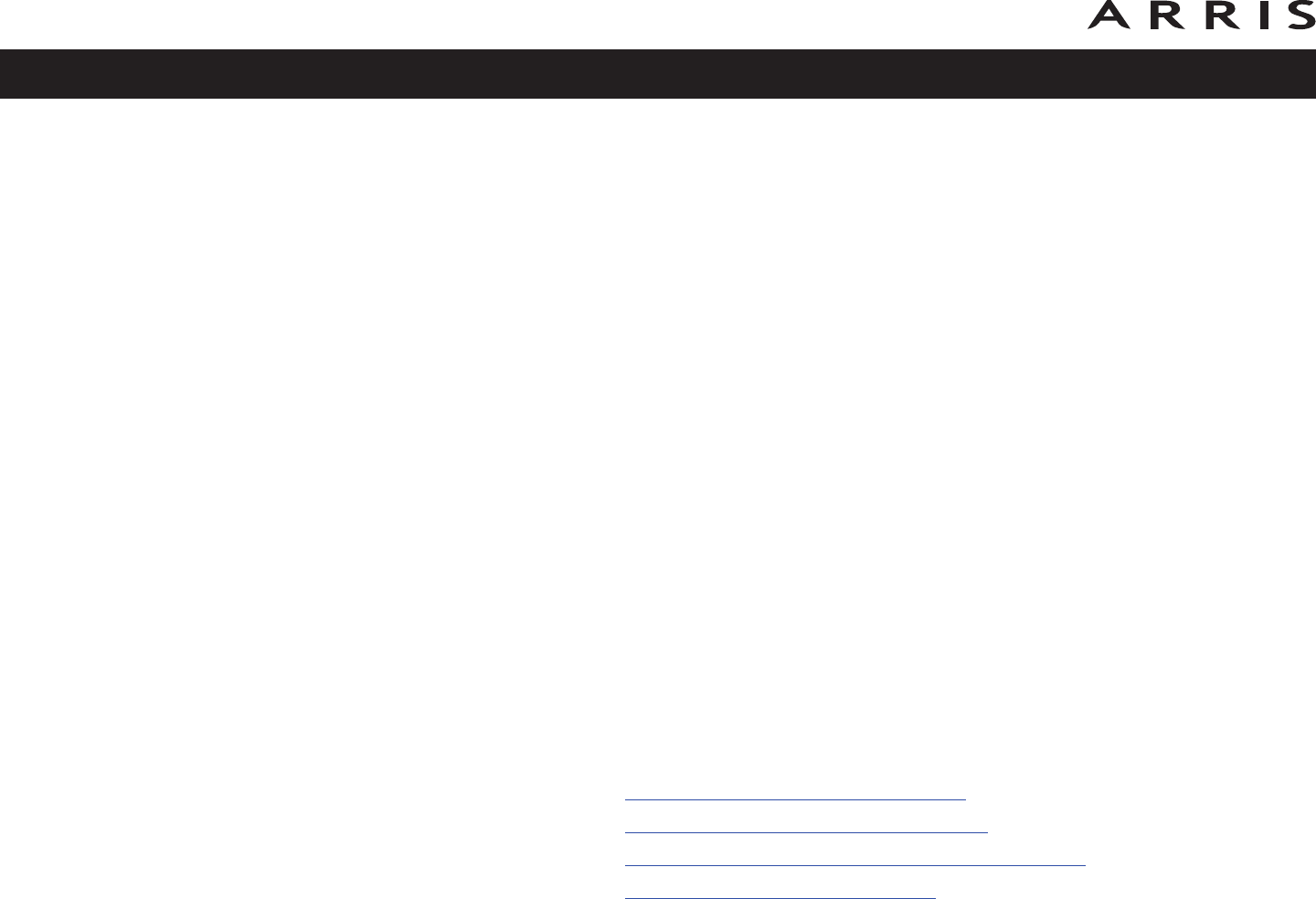
Configuring Your Ethernet Connection
If your computer is equipped with a LAN card providing an Ethernet connection,
you may have to configure your computer’s TCP/IP settings. The steps that follow
will guide you through setting your computer’s TCP/IP settings to work with the
Telephony Gateway.
Requirements
Make sure you have the following before attempting to configure your Ethernet con-
nection:
• Computer with:
— one of: Windows XP, Windows Vista, Windows 7, Windows 8, or MacOS
X
— Ethernet interface
• Ethernet cable (supplied)
• IP address, subnet, gateway, and DNS information for installations not using
DHCP
How to use this chapter
The following list shows the procedures for modifying the TCP/IP settings on the
computer. The procedure is slightly different depending on the operating system
that you are using. Please ensure you are using the correct steps for the operating
system on your computer. Follow the links below for instructions to configure your
Ethernet connection on your operating system.
•TCP/IP Configuration for Windows XP
•TCP/IP Configuration for Windows Vista
•TCP/IP Configuration for Windows 7 or Windows 8
•TCP/IP Configuration for MacOS X
Xfinity TG1682 Telephony Gateway User’s Guide
Safety
Getting
Started
Battery
Installation Installation
Ethernet
Configuration Usage Troubleshooting Glossary
24

TCP/IP Configuration for Windows XP
Follow these steps to configure the Ethernet interface on a Windows XP operating
system.
TCP/IPv6 Note: This procedure shows the configuration of TCP/IPv4. TCP/IPv6
is not installed or enabled by default in Windows XP. If your cable
provider requires TCP/IPv6 you must first install and enable it on your
Windows XP system. Refer to Microsoft support materials on Windows
XP for installation instructions. Once installed and enabled, follow this
same configuration example, but select TCP/IPv6 at the appropriate
step.
Note: Dialog boxes shown on your computer may differ slightly from those
shown in this procedure.
1From the computer, select Start > Settings > Control Panel and double-
click Network Connections in the Control Panel.
The Network Connection window displays a list of LAN connections and as-
sociated network adapters.
2Double-click the local area connection to be used for your device’s network
connection.
The Local Area Connection Status widow displays.
3Click Properties.
4Select TCP/IP by clicking it one time. Then click Properties.
5Click the General tab. Then click Obtain an IP address automatically
and click OK.
6Click OK to accept the new settings, and OK again to close the Properties
window.
7You may have to restart your computer in order for your computer to obtain
a new IP address from the network.
Xfinity TG1682 Telephony Gateway User’s Guide
Safety
Getting
Started
Battery
Installation Installation
Ethernet
Configuration Usage Troubleshooting Glossary
25

TCP/IP Configuration for Windows Vista
Follow these steps to configure the Ethernet interface on a Windows Vista operat-
ing system.
1Open the Vista Control Panel.
2Double-click Network and Sharing Center to display the Network and
Sharing Center window.
3. Click Manage Network Connections. If promted for a connection, choose
Local Area Connection.
The Network Connections window displays.
4Double-click the Local Area Connection to open the Properties window.
Note: If Windows requests permission to continue, click Continue.
5Double-click Internet Protocol Version 4 (TCP/IPv4) to configure
TCP/IPv4.
Note: If your cable provider requires TCP/IP version 6, double-click Inter-
net Protocol Version 6 (TCP/IPv6) to configure TCP/IPv6.
The TCP/IP properties window for the version you selected displays.
6. For either TCP/IPv4 or TCP/IPv6, select Obtain an IP address automati-
cally and Obtain DNS server address automatically, unless instructed
otherwise by your cable provider.
7Click OK to accept the new settings and close the Properties window.
Xfinity TG1682 Telephony Gateway User’s Guide
Safety
Getting
Started
Battery
Installation Installation
Ethernet
Configuration Usage Troubleshooting Glossary
26

TCP/IP Configuration for Windows 7 or Windows 8
Follow these steps to configure the Ethernet interface on a Windows 7 or Windows
8 operating system.
1Open the Windows Control Panel.
2Click Network and Internet.
3Click Network and Sharing Center.
4Click Local Area Connection to open the Status window.
5Click Properties to open the Properties window.
6Select Internet Protocol Version 4 (TCP/IPv4) and click Properties to
configure TCP/IPv4.
Note: If your cable provider requires TCP/IP version 6, select Internet Pro-
tocol Version 6 (TCP/IPv6) and click Properties to configure TCP/IPv6.
The TCP/IP properties window for the version you selected displays.
7For either TCP/IPv4 or TCP/IPv6, select Obtain an IP address automati-
cally and Obtain DNS server address automatically, unless instructed
otherwise by your cable provider.
8Click OK to accept the new settings and close the Properties window. Then
click Close to back out of the remaining setup screens.
Xfinity TG1682 Telephony Gateway User’s Guide
Safety
Getting
Started
Battery
Installation Installation
Ethernet
Configuration Usage Troubleshooting Glossary
27

TCP/IP Configuration for MacOS X
Follow these steps to configure the Ethernet interface on a MacOS X operating sys-
tem.
1Open System Preferences, either by choosing System Preferences from the
Apple menu or by clicking the System Preferences icon in the dock.
2Click the Network icon.
3Choose Automatic from the Location drop-down menu, and Built-in Eth-
ernet from the Show menu.
4Choose the TCP/IP tab, if necessary.
If you are using TCP/IPv4, go to step 5.
If your cable provider requires TCP/IPv6, go to step 8.
5Choose Using DHCP from the Configure IPv4 menu.
6If necessary, click the Renew DHCP Lease button.
7Close the System Properties application.
TCP/IPv4 configuration is completed.
8If you are using TCP/IPv6, click Configure IPv6 near the bottom of the pre-
vious window.
9Choose Automatically from the Configure IPv6 drop-down menu and click
OK.
10 Close the System Properties application.
Xfinity TG1682 Telephony Gateway User’s Guide
Safety
Getting
Started
Battery
Installation Installation
Ethernet
Configuration Usage Troubleshooting Glossary
28

29
Safety
Getting
Started
Battery
Installation Installation
Ethernet
Configuration Usage Troubleshooting Glossary
Xfinity TG1682 Telephony Gateway User’s Guide
Using the Telephony Gateway
This chapter describes the controls and features available on the Telephony Gate-
way, and covers basic troubleshooting procedures.
•Setting up Your Computer to Use the Telephony Gateway
•Indicator Lights for the TG1682
•Using the Reset Button
Setting up Your Computer to Use the Telephony
Gateway
Follow the instructions in the information packet supplied by your cable company.
Contact your cable company if you need help setting up your computer.
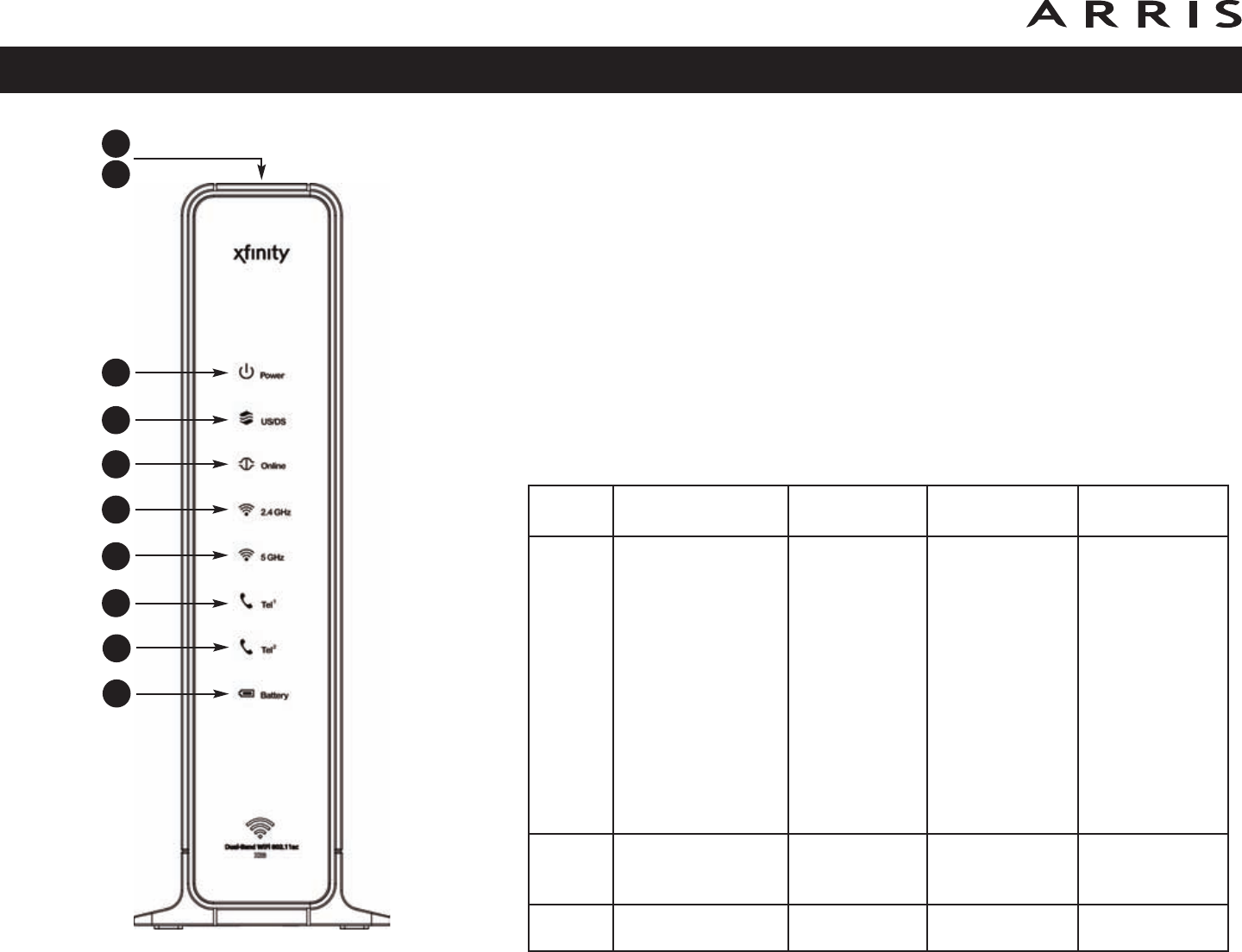
30
Safety
Getting
Started
Battery
Installation Installation
Ethernet
Configuration Usage Troubleshooting Glossary
Xfinity TG1682 Telephony Gateway User’s Guide
Indicator Lights for the TG1682
The Xfinity Telephony Gateway has several LED indicator lights to assist in trouble -
shooting.
Wiring Problems
If the Telephony Gateway begins flashing all its lights for more than 10 seconds, this
indicates a problem with the telephone wiring — the red and green wires may be
shorted (touching), or there may be undesired voltage on the lines. If this pattern
persists for more than 10 seconds, disconnect the telephone lines from the Tele-
phony Gateway, then call a wiring technician for assistance.
Patterns: Normal Operation (LAN and Telephone)
The following table shows light patterns for the Ethernet, MoCA and wireless LANs,
and the telephones, during normal operation.
Mode Ethernet
(rear panel)
2.4 GHz/
5 GHz WiFi Tel 1 / Tel 2 MoCA
(rear panel)
AC
Power
Green LED On =
Computer with 1
Gbps port connected
Amber LED On =
Computer with 100
Mbps/10 Mbps port
connected
Amber/Green LED
Flash = Computer
activity
Both LEDs Off =
Computer not
connected
On = WiFi
Enabled
Off = WiFi
Disabled
Flash =
Computer
Activity
On = On-hook
Flash = Off-hook
Off = disabled
On = MoCA
enabled
Flash = MoCA
network device
activity/traffic
Off = MoCA
disabled
No AC
Power Off Off
On = On-hook
Flash = Off-hook
Off = disabled
Off
Firmware
Upgrade (normal operation) (normal operation) (normal operation) (normal operation)
B
E
C
A
D
F
H
G
J
I
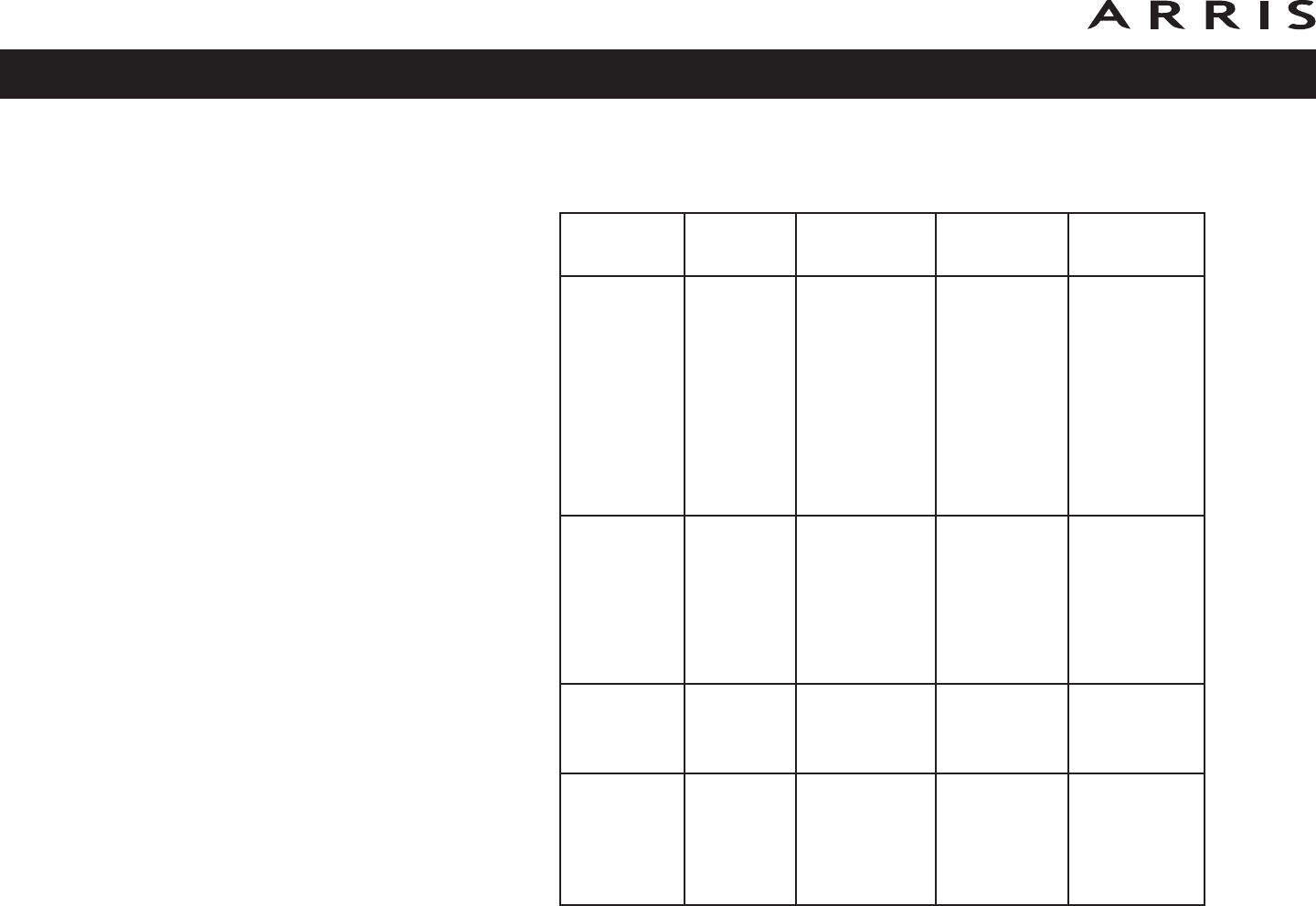
Patterns: Normal Operation (WAN and Battery)
The following table shows light patterns during normal operation.
Mode Power US/DS Online Battery
AC Power
Good On
On =
Connected
to the
Internet
Flash = Not
connected
to the
Internet
On =
Internet
available
Off =
Internet
not
available
On =
Battery
good or low
Off =
Battery
missing
Flash =
Battery bad
No AC
Power Bat-
tery In-
stalled
Flash Off Off
Off =
Battery
power
Flash =
Battery bad
No AC
Power No
Battery
Off Off Off Off
Firmware
Upgrade On Flash On (normal
operation)
Xfinity TG1682 Telephony Gateway User’s Guide
Safety
Getting
Started
Battery
Installation Installation
Ethernet
Configuration Usage Troubleshooting Glossary
31
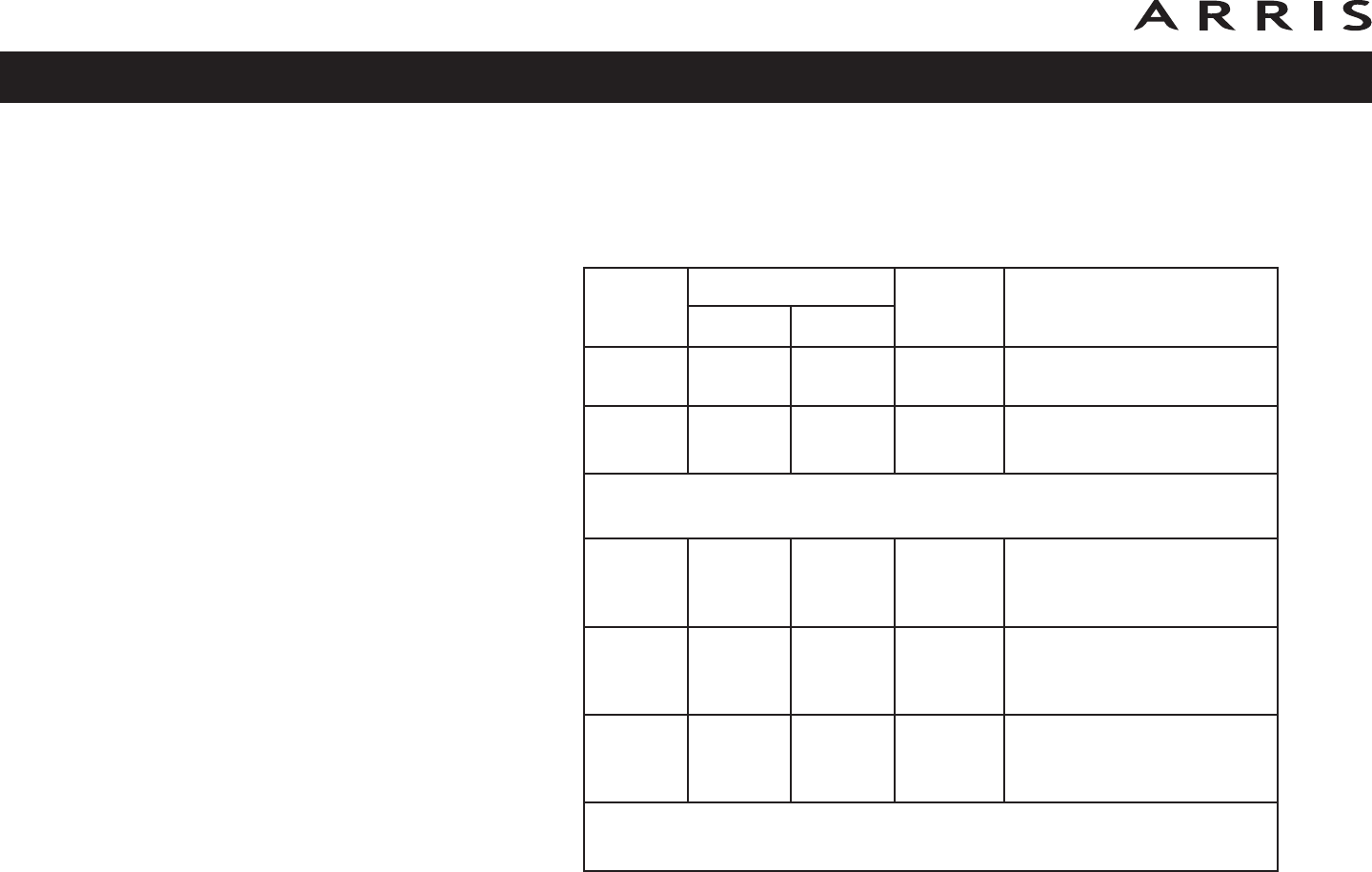
32
Safety
Getting
Started
Battery
Installation Installation
Ethernet
Configuration Usage Troubleshooting Glossary
Xfinity TG1682 Telephony Gateway User’s Guide
Patterns: Startup Sequence
The following table shows the Telephony Gateway light patterns during each phase
of the startup sequence. There are two phases of startup; the Telephony phase and
the cable modem phase. Both are outlined below.
Note: The US/DS indicator flashes during startup, and turns on when the Tele-
phony Gateway establishes a connection.
Power,
US/DS,
Online
Telephone
Battery Description
1 2
Off Off Off Off No power to Modem
Flash Flash Flash Flash Power-on Self Test
“Cable Modem Start Up Sequence” Begins
On Flash Off Off Retrieving telephone net-
work information
On Off Flash Off Retrieving telephone line
information
On Flash Flash Off Activating telephone
service
Normal Operation Begins
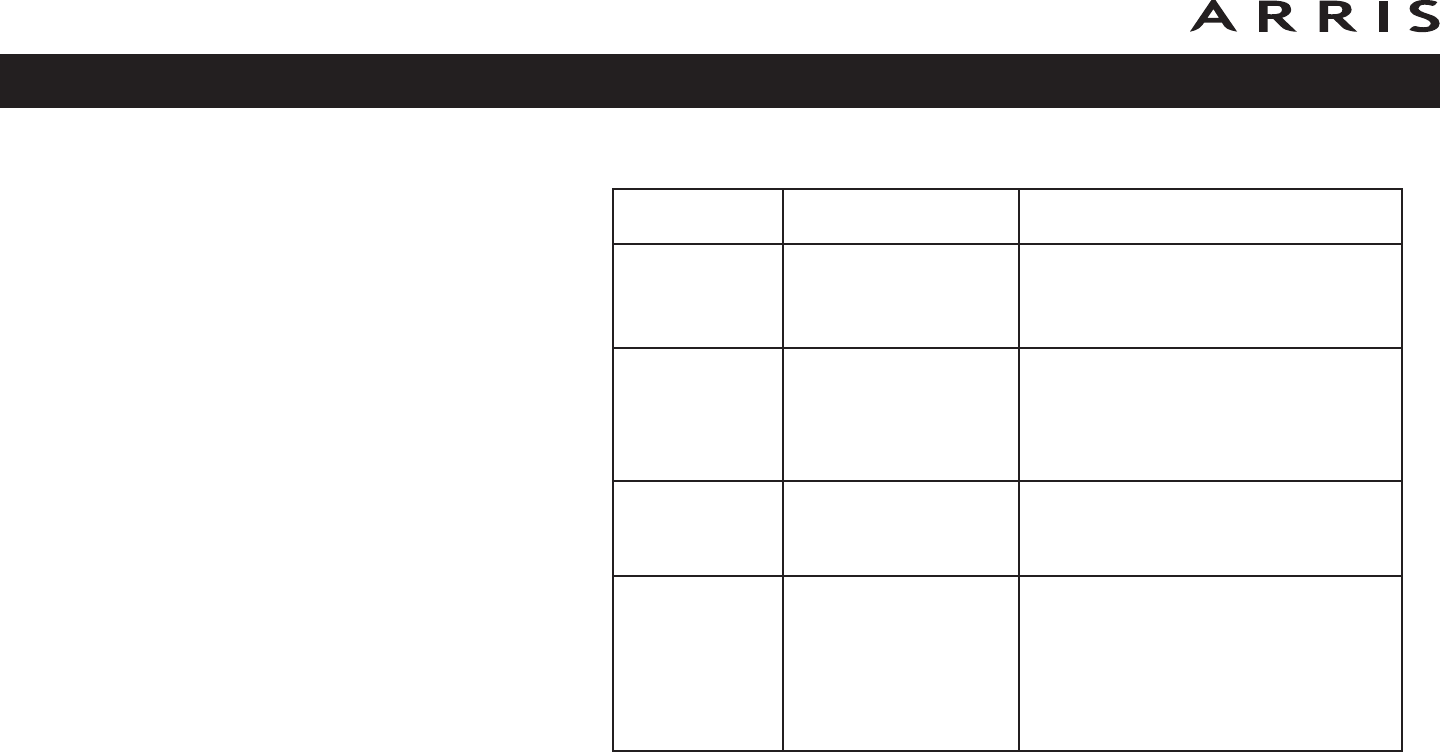
Cable Modem Start Up Sequence
US/DS Online Description
Slow Flash
(1/second) Off Downstream acqusition in progress
On
(until Upstream
acqusition
starts)
Off Downstream acquisition completed
Fast Flash
(3/second) Off Upstream acquisition completed
On
Slow Flash
(during acqusition)
On (when modem IP
address obtained)
Upstream acqusition completed,
ready for service
Xfinity TG1682 Telephony Gateway User’s Guide
Safety
Getting
Started
Battery
Installation Installation
Ethernet
Configuration Usage Troubleshooting Glossary
33
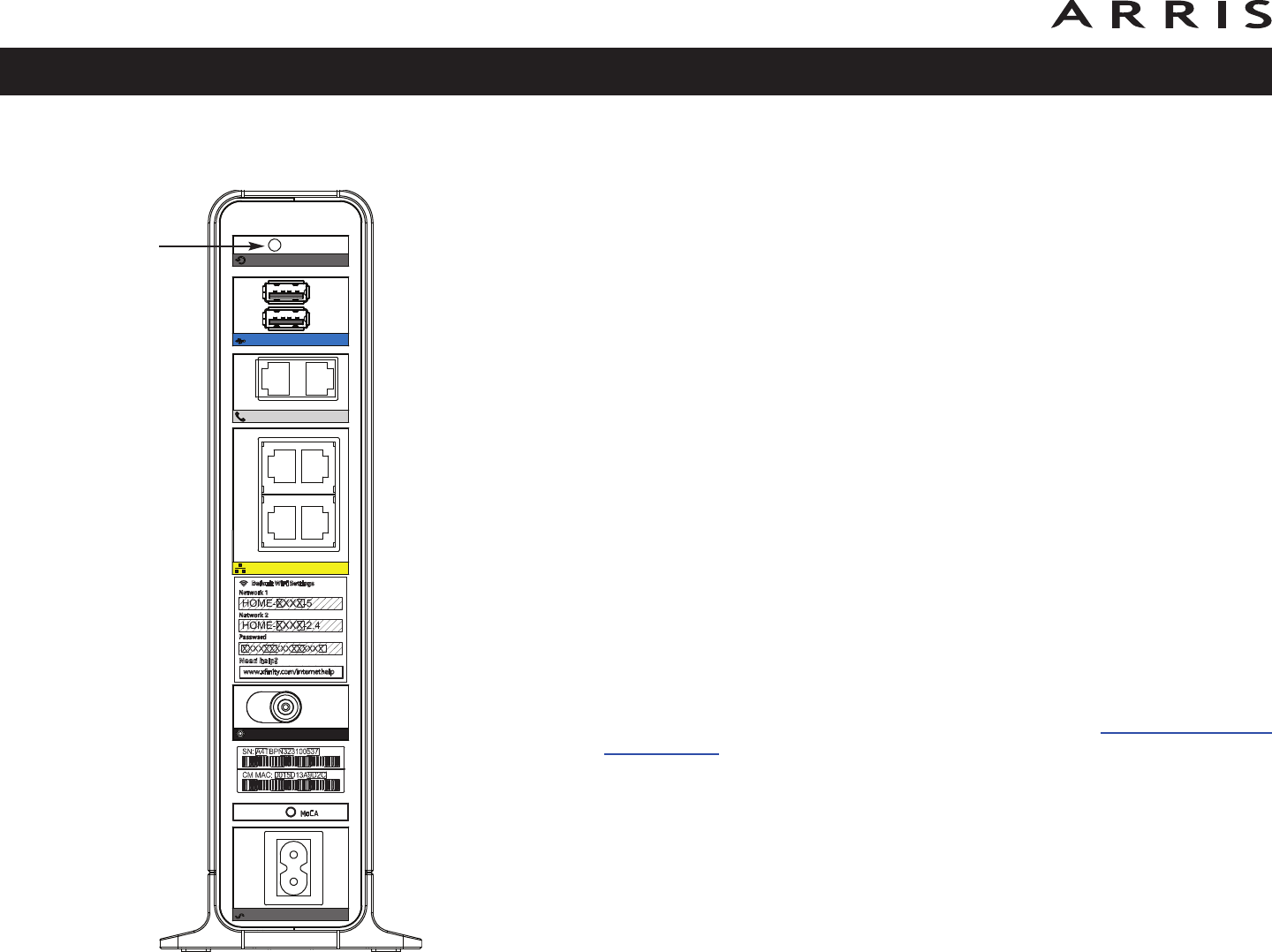
Using the Reset Button
Use the Reset button, on the back of the Telephony Gateway, to reset the modem
and perform initialization as if you power cycled the unit. You may need to reset the
Telephony Gateway if you are having problems connecting to the Internet. Using
this button will be rare.
Use a pointed non-metallic object to press this button. The photo to the left shows
the location of the Reset button. The Reset button is recessed to prevent acci-
dental resets.
The diagram on the left shows the location of the reset button.
Resetting the Router to Factory Defaults
To reset the router to factory defaults, press and hold the Reset but ton on the back
of the Telephony Gateway for more than fifteen seconds. This restores the wireless
setup configuration and router configuration parameters to the factory defaults. You
may need to do this if a misconfiguration has locked out all access.
Booting from Battery
The TG1682 supports a “Boot from Battery” feature that allows the Telephony Gate-
way to provide voice service without AC power.
To start the TG1682 from its battery, follow these steps:
1If a battery is already installed in the Telephony Gateway, remove it.
2Re-insert the battery into the Telephony Gateway (see Battery Installation
and Removal for details).
3Press the Reset button; the Power light should turn on immediately.
Xfinity TG1682 Telephony Gateway User’s Guide
Safety
Getting
Started
Battery
Installation Installation
Ethernet
Configuration Usage Troubleshooting Glossary
34
Reset
USB
Tel
Tel 1 Alarm/Tel2
12
34
Ethernet
Cable
Power
Reset
Button
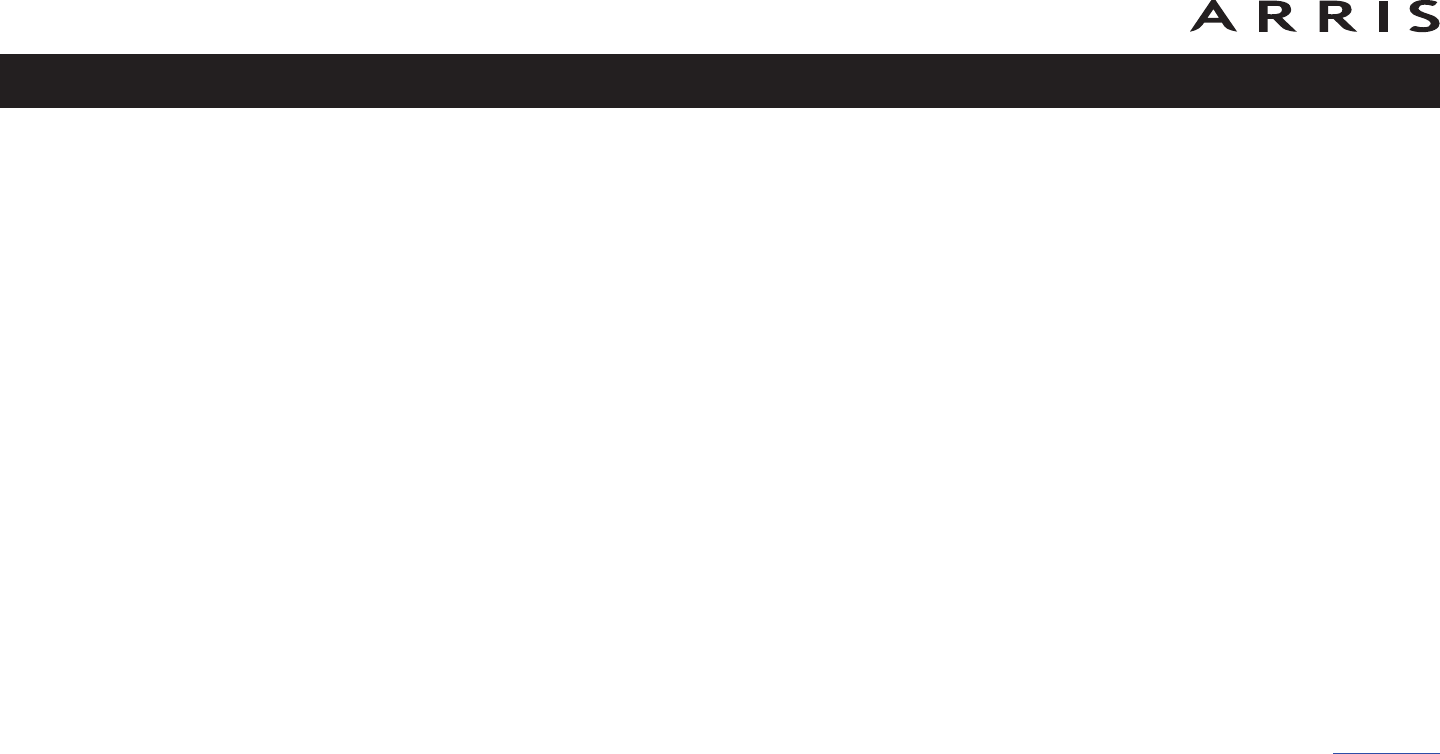
Troubleshooting
The Telephony Gateway is plugged in, but the Power light is off.
Check all power connections. Is the power cord plugged in firmly at both
ends?
If you plugged the power cord into a power strip, make sure the strip is
switched on.
Avoid using an outlet controlled by a wall switch, if possible.
Finally, check the fuse or circuit breaker panel.
I’m not getting on the Internet (all connections).
It may take over 30 minutes to establish a connection the first time you
power up your Telephony Gateway, especially when many people are online.
Always leave your Telephony Gateway plugged into AC power and connected
to the cable system.
Check the front panel lights:
• The Power and Online lights should be on.
• If the Power light blinks for more than 30 minutes, call your cable
company for assistance.
Check your cable connections. Connectors should be tight. The coax cable
should not be pinched, kinked, or bent sharply—any of these can cause a
break or short in the cable (you may have to replace the cable). If you have
one or more splitters between the Telephony Gateway and CATV outlet, re-
move the splitters and connect the Telephony Gateway directly to the out-
let.
Proceed to the Ethernet or wireless solutions (next page) if necessary.
Xfinity TG1682 Telephony Gateway User’s Guide
Safety
Getting
Started
Battery
Installation Installation
Ethernet
Configuration Usage Troubleshooting Glossary
35
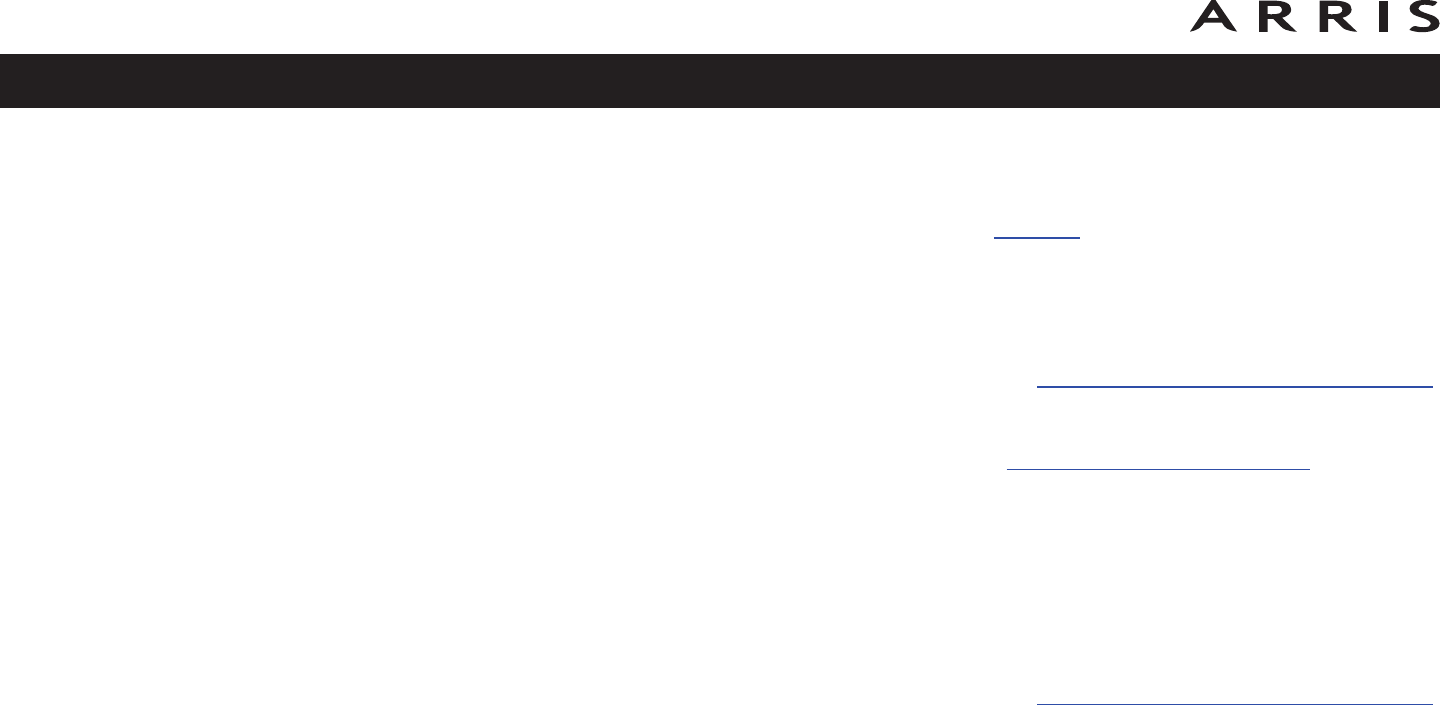
I’m not getting on the Internet. (Ethernet)
If you are using a hub, is the hub turned on?
Are you using the right type of Ethernet cable? Use a straight-through cable
for direct connection to a computer; use a cross-over cable for connection
to a hub without a cross-over switch.
Press the Reset button on the back of the Telephony Gateway.
A misconfiguration could lock out all access to the Telephony Gateway router.
If you think this has happened, see Resetting the Router to Factory Defaults.
I’m not getting on the Internet. (Wireless)
Check the indicator lights (see Using the Telephony Gateway) — the WiFi
light should be on.
Does your connection utility discover your wireless LAN? If you turned off
“Broadcast SSID” you need to manually enter the name of your wireless LAN
in the connection utility.
Change your security mode to “disabled”. Enable one of the other security
modes as soon as you find the problem.
A misconfiguration could lock out all access to the Telephony Gateway router.
If you think this has happened, see Resetting the Router to Factory Defaults.
My wireless Internet connection stops working sometimes.
This is usually caused by interference — two common sources are 2.4GHz
“remote” telephones and microwave ovens. If you cannot remove the inter-
fering product, try using a different channel or setting Protected Mode.
I can get on the Internet, but everything is slow.
If the Web site you are visiting is very popular, that site may be having trou-
ble servicing all the requests. If other sites download quickly, wait for a few
minutes and try again. Usage during peak hours may also affect the con nec-
tion speed.
Other communications on the LAN, or interference with wireless connec-
tions, may slow down your connection.
Xfinity TG1682 Telephony Gateway User’s Guide
Safety
Getting
Started
Battery
Installation Installation
Ethernet
Configuration Usage Troubleshooting Glossary
36

I don’t have dial tone when I pick up my phone, why?
In order for telephone service to be functional on the Telephony Gateway,
telephone service must have been purchased from the service provider and
configured on your Telephony Gateway. The following steps should help in
identifying the source of the problem.
1Is the Power LED lit?
• If not, check to make sure the Telephony Gateway is plugged in
and the outlet has power.
• If the LED is lit, go to the next step.
2Is the Online LED lit?
• If not, check the coax connection at the Telephony Gateway and
the wall. Ensure they are connected and tight. If they are and
you do not have dial tone, contact your service provider.
• If the Online LED is lit, go to the next step.
3Is the Telephone (Tel 1 or Tel 2) LED lit?
• If not, phone service has not been set up on that line. Contact
your service provider.
• If it is blinking, there is a phone off hook somewhere in the
house. Find that phone and hang it up.
• If it is lit, go to the next step.
4Is the phone plugged directly into the Telephony Gateway?
• Make sure the phone is plugged into the port on the back of the
Telephony Gateway labeled “Tel 1” for line 1, and “Alarm/Tel 2” for
line 2.
• If so, try a different phone. Make sure the new phone is a work-
ing phone.
• If a known good phone is used and you still don’t have dial tone,
try a different phone cable. If a new phone and cable do not re-
store dial tone, call your service provider.
Xfinity TG1682 Telephony Gateway User’s Guide
Safety
Getting
Started
Battery
Installation Installation
Ethernet
Configuration Usage Troubleshooting Glossary
37

5Is the Telephony Gateway plugged into a wall outlet?
• If so, unplug the RJ-11 connector at the back of the Telephony
Gateway and plug in a known working phone. If you now have
dial tone, the problem is with the house wiring. Contact your
cable company or a qualified wiring technician to correct the
house wiring. If you still do not have dial tone, contact your serv-
ice provider.
Xfinity TG1682 Telephony Gateway User’s Guide
Safety
Getting
Started
Battery
Installation Installation
Ethernet
Configuration Usage Troubleshooting Glossary
38

Glossary
The following is a list of common cable and networking terms.
Amp-hour (Ah)
A measure of battery capacity. For example, a 1.0Ah battery can nominally
supply one Ampere of current for one hour.
Category 5e (Cat5e)
A high-quality type of cable, used for gigabit Ethernet (1000BaseT) connec-
tions. When purchasing Ethernet cables, always look for Category 5e cable.
Coaxial cable (coax)
A thin wire, used to connect your television and Telephony Gateway to the
cable TV system. You can buy coax from any electronics retailer and many
discount stores.
CPE
Customer Premise Equipment. This is the equipment that is plugged in to the
Telephony Gateway; typically a computer or hub.
Cross-over
An Ethernet cable used to connect two hubs (or a hub and a cable modem)
together. Also, some Ethernet hubs may have built-in cross-over on one or
more ports (which eliminates the need for a cross-over cable).
DHCP
Dynamic Host Configuration Protocol. An IP protocol used to provide an IP
address and location of services (such as DNS and TFTP) needed by a de-
vice connecting to the network. DHCP allows the cable company to con figure
your computer’s networking software for you.
DNS
Domain Name Service (Server). An IP service that associates a domain
name (such as www.example.com) with an IP address.
Xfinity TG1682 Telephony Gateway User’s Guide
Safety
Getting
Started
Battery
Installation Installation
Ethernet
Configuration Usage Troubleshooting Glossary
39

Downstream
In an HFC network, the direction from the head-end to the subscriber. Some
older cable documentation may refer to this as the forward path.
DOCSIS
Data Over Cable System Interface Specification. The interoperability stan-
dards used for data communications equipment on an HFC network.
EMTA
Embedded Multimedia Terminal Adapter. An MTA device that is integrated
with a cable modem.
Ethernet
A standard method of connecting two or more computers into a Local Area
Network (LAN).
EuroDOCSIS
The European version of DOCSIS.
Event
An informational message used for monitoring network status.
F-connector
The type of connector used on coax cable. There are two common types of
F-connector, slip-on and screw-on. Use coax with screw-on connectors for
connecting your Telephony Gateway.
Firewall
A hardware or software device that prevents unauthorized access to a pri-
vate network from the Internet. The TG1682 provides a built-in firewall.
Gateway
The device, usually a router, that connects devices on a given IP subnet to
other IP subnets.
Xfinity TG1682 Telephony Gateway User’s Guide
Safety
Getting
Started
Battery
Installation Installation
Ethernet
Configuration Usage Troubleshooting Glossary
40

Headend
The “central office” in an HFC network. The headend houses both video and
data equipment. In larger cable networks, a “master” headend often feeds
several “remote” headends to provide distributed services.
HTTP
HyperText Transfer Protocol.
Hub
A box with several Ethernet connectors. Ethernet hubs provide a common
point of contact for all connected devices.
IP address
A number assigned to your computer by your cable company, used to iden-
tify your computer to other systems on the Internet.
ISDN
Integrated Services Digital Network. A digital telephony standard that pro-
vides communication speeds about twice as fast as standard dialup.
LAN
Local Area Network. A network that allows computers in a single location
(such as a building) to communicate with one another.
LED
Light Emitting Diode. A semi-conductor diode that emits light when current
is passed through it.
MAC address
A number that uniquely identifies any device connected to a network. Your
cable company uses your Telephony Gateway’s MAC address to authorize
access to the Internet. The MAC address is printed on a label on the bottom
of your Telephony Gateway.
Protocol
A set of rules and formats that determines the communication behavior of
network entities at a given layer.
Xfinity TG1682 Telephony Gateway User’s Guide
Safety
Getting
Started
Battery
Installation Installation
Ethernet
Configuration Usage Troubleshooting Glossary
41

Proxy
A device or program that stands in between a server (for example, a web
site) and a client (your browser), providing a way to relieve some of the
burden from the server. For example, your cable company may have a web
proxy that keeps copies of popular web pages; the proxy can send you those
pages instead of fetching them directly from the web site, resulting in faster
page loading and less network congestion.
RF
Abbreviation for Radio Frequency. Some literature refers to coax as “RF
cable” and the connectors as “RF connectors.”
RJ-11
A standard 2-conductor modular connector, commonly used in North Amer-
ica for connecting telephones.
RJ-45
A standard 8-conductor modular connector, commonly used on Ethernet
cable. An RJ-45 connector looks like a wide RJ-11 (telephone) connector.
Splitter
A small box with three cable connectors: one input and two outputs. You
may need a splitter if you have a TV already connected to the cable outlet
that you want to use for your Telephony Gateway. You can buy a splitter
from any electronics retailer and most discount stores.
SSID
Service Set IDentifier, a string of text (up to 32 characters long) that
uniquely identifies a wireless LAN.
Switched outlet
A power outlet that may be turned on and off using a wall switch. Usually
intended for lamps. Avoid plugging your computer or Telephony Gateway
into a switched outlet to avoid disruptions.
TCP/IP
Transmission Control Protocol/Internet Protocol. The protocols used to facil-
itate communications across one or more connected networks.
Xfinity TG1682 Telephony Gateway User’s Guide
Safety
Getting
Started
Battery
Installation Installation
Ethernet
Configuration Usage Troubleshooting Glossary
42

TDMA
Time Division Multiple Access. A method used by DOCSIS-compliant cable
modems for sending upstream data with minimal interference.
Upstream
The path from a subscriber device to the headend. Some older cable docu-
mentation may refer to this as the return path or reverse path.
WEP
Wired Equivalent Privacy, a common standard for encrypting data sent over
a wireless LAN.
WPA
Wi-fi Protected Access, a standard for encrypting data sent over a wireless
LAN. WPA offers improved security over WEP.
Xfinity TG1682 Telephony Gateway User’s Guide
Safety
Getting
Started
Battery
Installation Installation
Wireless
Configuration
Ethernet
Configuration Usage Troubleshooting Glossary
43
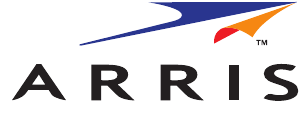
©ARRIS Enterprises, Inc. 2014 All rights reserved. No part
of this publication may be reproduced in any form or by
any means or used to make any derivative work (such as
translation, transformation, or adaptation) without written
permission from ARRIS Enterprises, Inc. (“ARRIS”). ARRIS
reserves the right to revise this publication and to make
changes in content from time to time without obligation on
the part of ARRIS to provide notification of such revision
or change.
ARRIS provides this guide without warranty of any kind,
implied or expressed, including, but not limited to, the im-
plied warranties of merchantability and fitness for a partic-
ular purpose. ARRIS may make improvements or changes
in the product(s) described in this manual at any time. The
capabilities, system requirements and/or compatibility with
third-party products described herein are subject to change
without notice.
ARRIS and the ARRIS logo are all trademarks of ARRIS En-
terprises, Inc. Other trademarks and trade names may be
used in this document to refer to either the entities claim-
ing the marks and the names of their products. ARRIS dis-
claims proprietary interest in the marks and names of
others.
Protected under one or more of the following U.S. patents:
7,031,435. Other patents pending.
Release 16 Standard 1.6 November 2014
Xfinity TG1682 Telephony Gateway User’s Guide
Export Regulations
Safety Requirements
FCC Part 15
RF Exposure
Getting Started
About Your New Telephony Gateway
What’s in the Box?
Items You Need
Getting Service
System Requirements
Recommended Hardware
Windows
MacOS
Linux/other Unix
About this Manual
What About Security?
Ethernet or Wireless?
Wireless
Both
Battery Installation and Removal
Basic Battery Installation and Replacement
Extended Battery Installation and Replacement
Installing and Connecting Your Telephony Gateway
Front Panel
Rear Panel
Selecting an Installation Location
Desktop mounting instructions
Cleaning Instructions
Factors Affecting Wireless Range
Connecting the Telephony Gateway
Configuring Your Wireless Connection
Configuring Your Ethernet Connection
Requirements
How to use this chapter
TCP/IP Configuration for Windows XP
TCP/IP Configuration for Windows Vista
TCP/IP Configuration for Windows 7 or Windows 8
TCP/IP Configuration for MacOS X
Using the Telephony Gateway
Setting up Your Computer to Use the Telephony Gateway
Indicator Lights for the TG1682
Wiring Problems
Patterns: Normal Operation (LAN and Telephone)
Patterns: Normal Operation (WAN and Battery)
Patterns: Startup Sequence
Cable Modem Start Up Sequence
Using the Reset Button
Resetting the Router to Factory Defaults
Booting from Battery
Troubleshooting
Glossary
Xfinity
TG1682 Telephony Gateway
User’s Guide